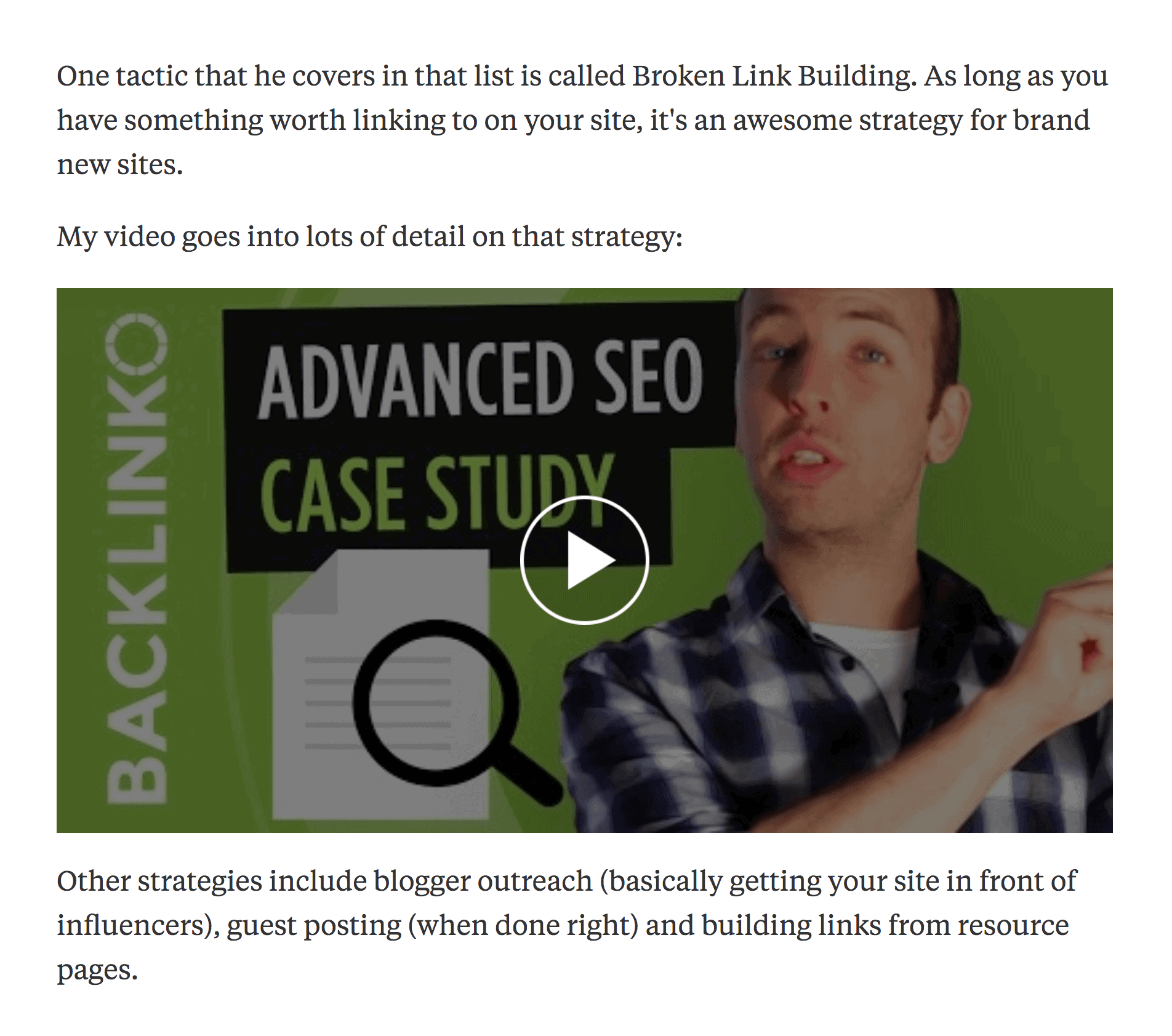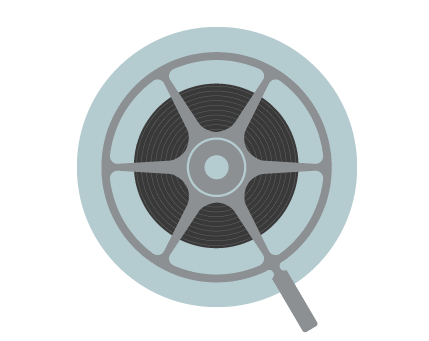Video SEO: The Definitive Guide
This guide has everything you need to know about video SEO.
So if you want to rank your videos on YouTube and Google, you’re in the right place.
Keep reading…

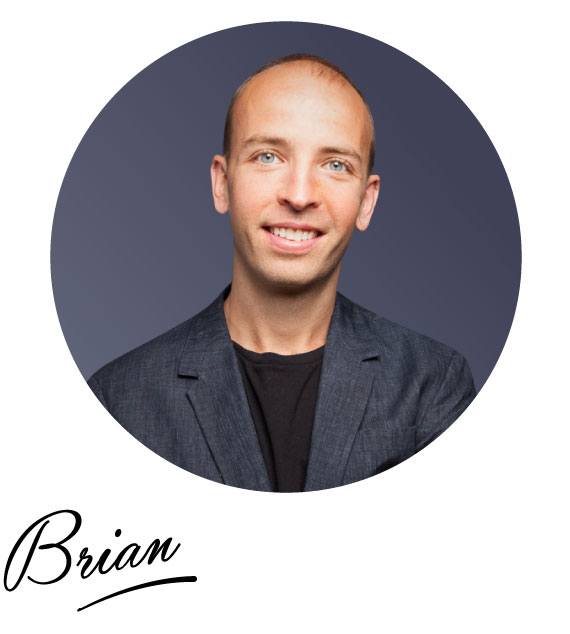
About The Author
I’m Brian Dean.
My first YouTube channel was a complete disaster.
I consistently uploaded high-quality videos…but no one watched them. (In fact, each of my videos averaged only 27 total views).
Yikes.
That’s when I decided to take YouTube SEO seriously.
Today, I rank for some of the most competitive keywords on YouTube, like “YouTube SEO”…
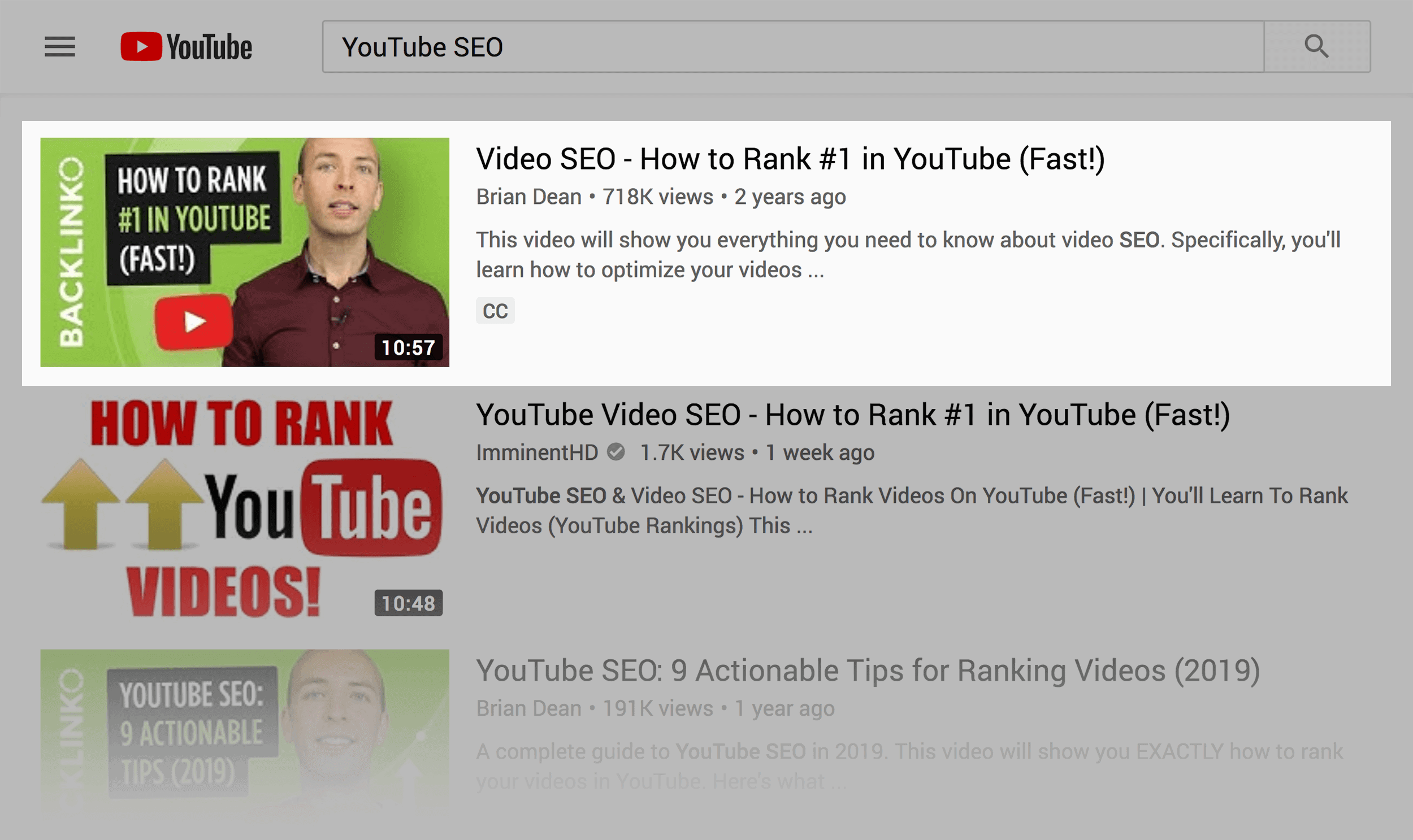
…and “link building”:

And today I’m going to show you exactly how I did it (step-by-step).
Chapter 1:Video Keyword Research

Keyword research for videos is completely different than for text-based blog posts.
Why?
Two reasons:
Reason #1: Most of your views come from YouTube suggesting your video to their users.
(Not from search engines)
Yes, you should optimize your videos for YouTube and Google search. But most people only get around 15-25% of their video traffic from search.
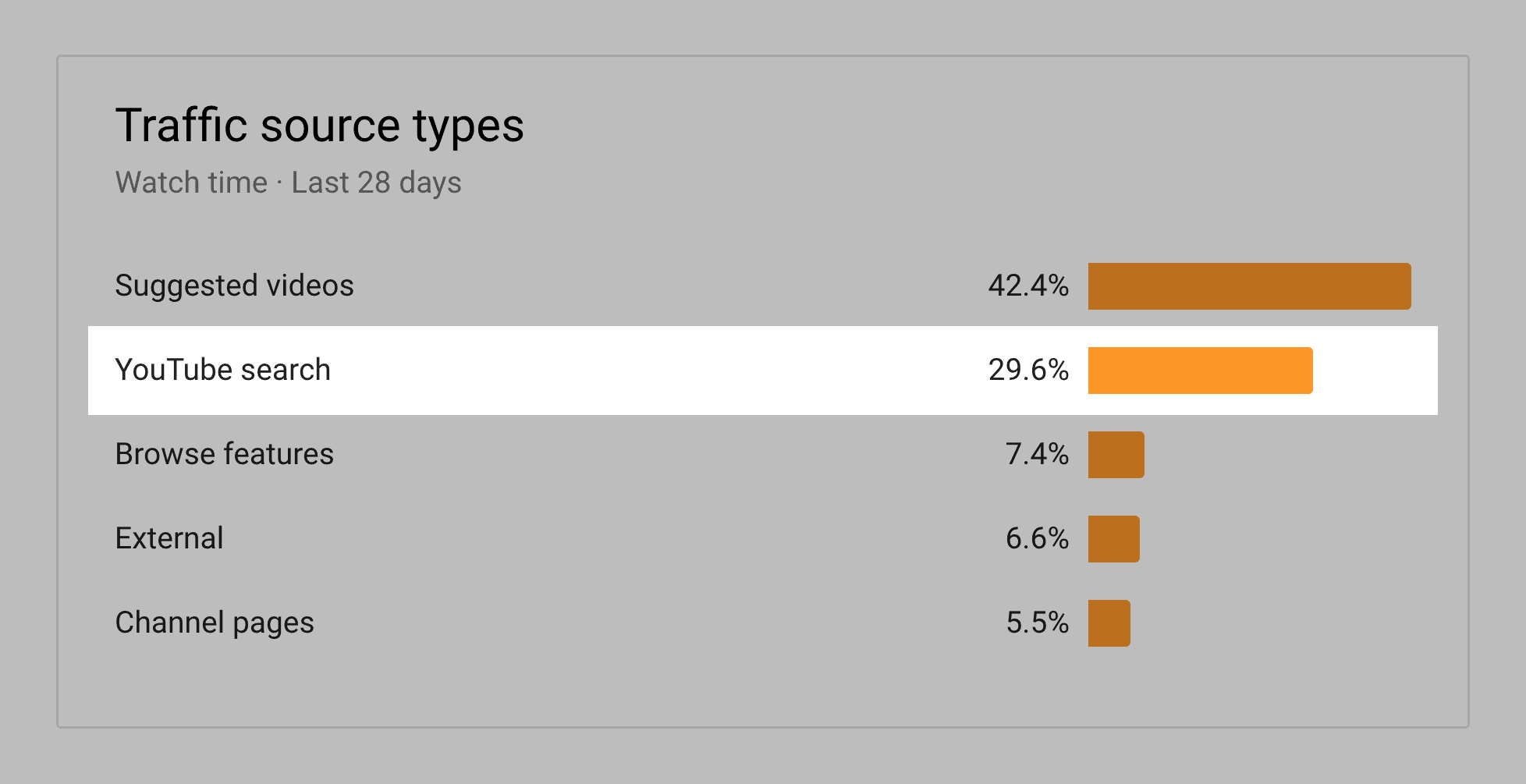
The rest come from suggested videos and “browse features”. I’ll show you how to optimize for these features later in this guide.
Reason #2: People use Google and YouTube in completely different ways.
A keyword that gets 100k monthly searches in Google (like “life insurance”) may get only 50 in YouTube.
On the other hand, a keyword that gets a bazillion searches in YouTube (like “cute cats”), will get significantly less in Google.
(That said, tons of people search for cute cats on any platform. It’s the internet after all 🙂 )
Now it’s time for me to show you my 5 favorite video keyword research techniques.
In the near future, I’ll also walk you through the new workflows in tools such as the Semrush apps Keyword Analytics for YouTube, or Rank Tracker for YouTube.
YouTube Suggest
This works just like Google Suggest.
Type a keyword into the search field. Get a list of suggestions:

Don’t underestimate the power of this technique. YouTube is literally telling you the exact keywords people search for. HUGE.
TubeBuddy Tags
This nifty (free) extension show you the exact tags your competitors use for their videos.
First, install the extension on your Google Chrome browser:

Then head over to a competitor’s video. Click the “tags” tab:

This will show you that video’s tags:
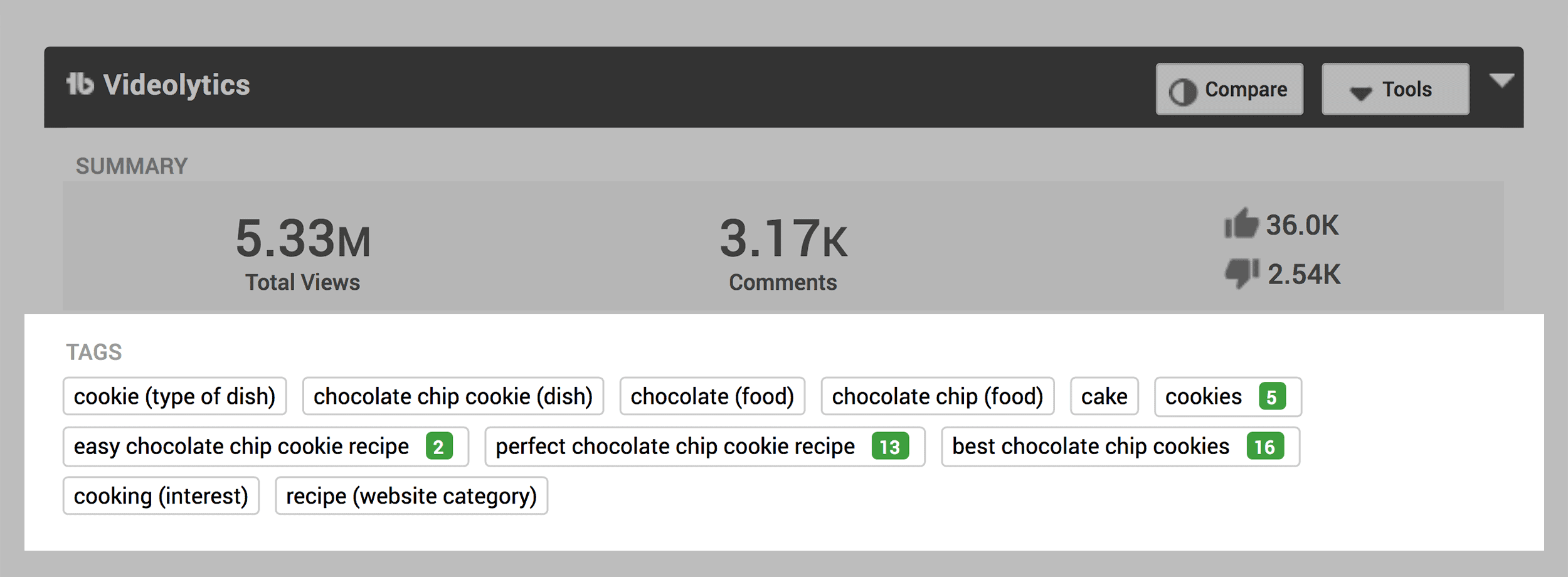
Also, the green numbers show you where that video ranks for those terms in YouTube search:

So if you find a poorly-optimized video that ranks for a keyword, add it to your list.
You can probably outrank that video by publishing a high-quality, keyword-optimized video (I’ll show you exactly how to optimize your videos in Chapter 3).
VidIQ Keyword Search
VidIQ is a powerful freemium tool that with a focus on YouTube keyword research. And it’s one of my favorite ways to uncover amazing keyword and topic ideas for my videos.
Here’s how to use it:
First, head over to the site and sign up.

Login and click on “SEO” in the top navigation.

Then, enter a keyword into it:

Boom! You get a list of keyword ideas. And helpful info to help you uncover low-competition, high-volume terms.

YT Cockpit
YTCockpit is one of the few keyword research tools on the market designed specifically for YouTube.
To use it, enter a seed keyword into the tool:
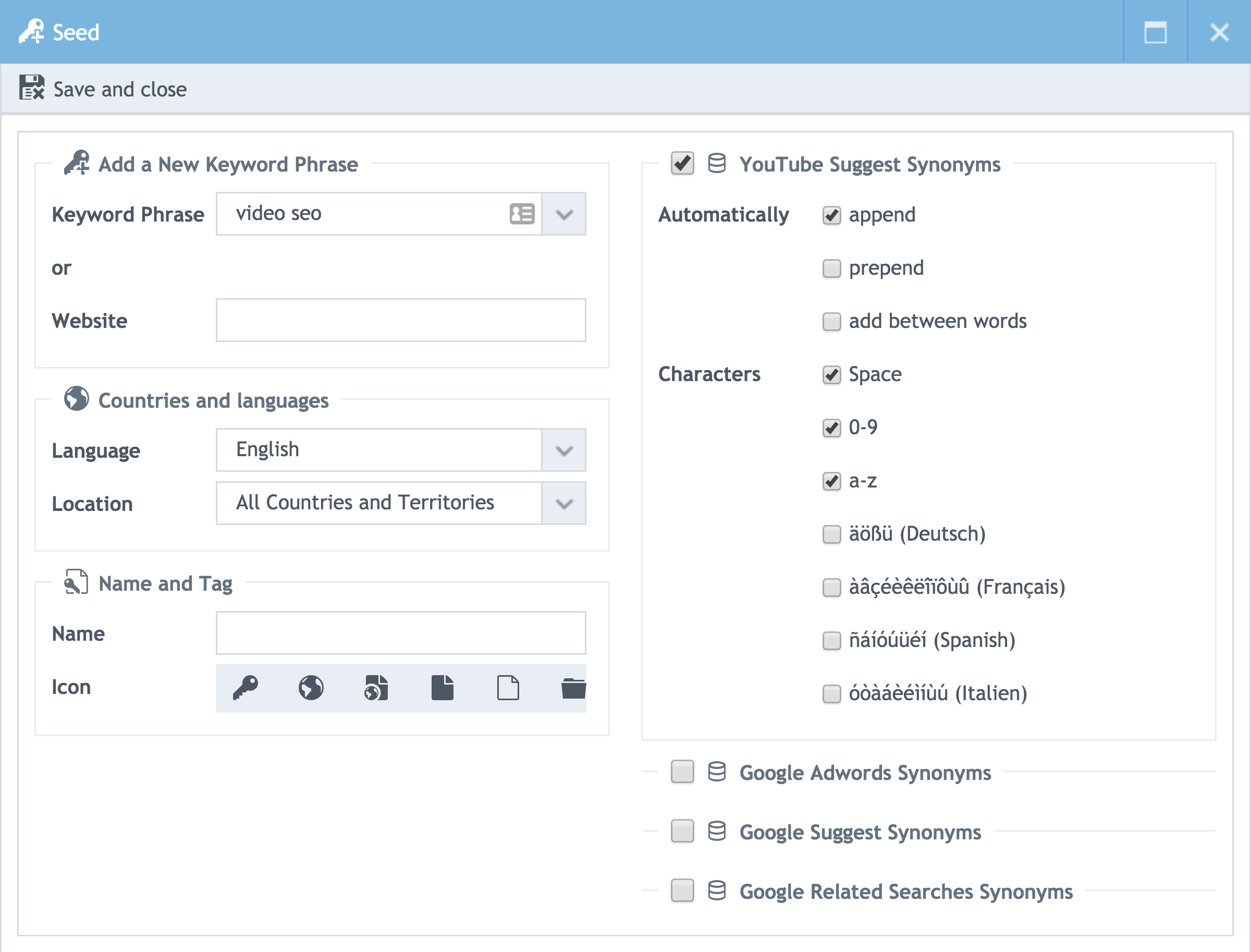
YTCockpit will show you a slew of keyword suggestions…and important metrics for each keyword.
Like any keyword research tool worth its salt, YTCockpit shows you basic information for each keyword suggestion (like search volume and CPC).

(It’s important to note that “Monthly Searches” in YTCockpit represent the amount of Google searches. So yeah, it’s not 100% accurate. But these numbers give you a rough idea of the interest people have on that topic).
But what I REALLY like about this tool is that it sizes up the competition in YouTube.
YTCockpit shows you the average video length, number of likes and amount of comments for each video that ranks for a given keyword:

And if you click on a keyword suggestion, they’ll show you a detailed breakdown of the YouTube SERP:

Why is this helpful?
If you see that the first page is packed with massively successful videos, you probably want to scratch that keyword off of your list.
(It takes A LOT of time and energy to make a video. And don’t want to create a video that’s going to get buried.)
This competition analysis feature helps you avoid this pesky problem.
YouTube Studio Stats
I saved the best for last.
If your channel has at least some traction, YouTube Studio will be your BEST source of awesome keywords.
Why? Because YouTube Studio shows you keywords that you already rank for.
Let me show you how it’s done:
First, head over to your YouTube Studio dashboard.
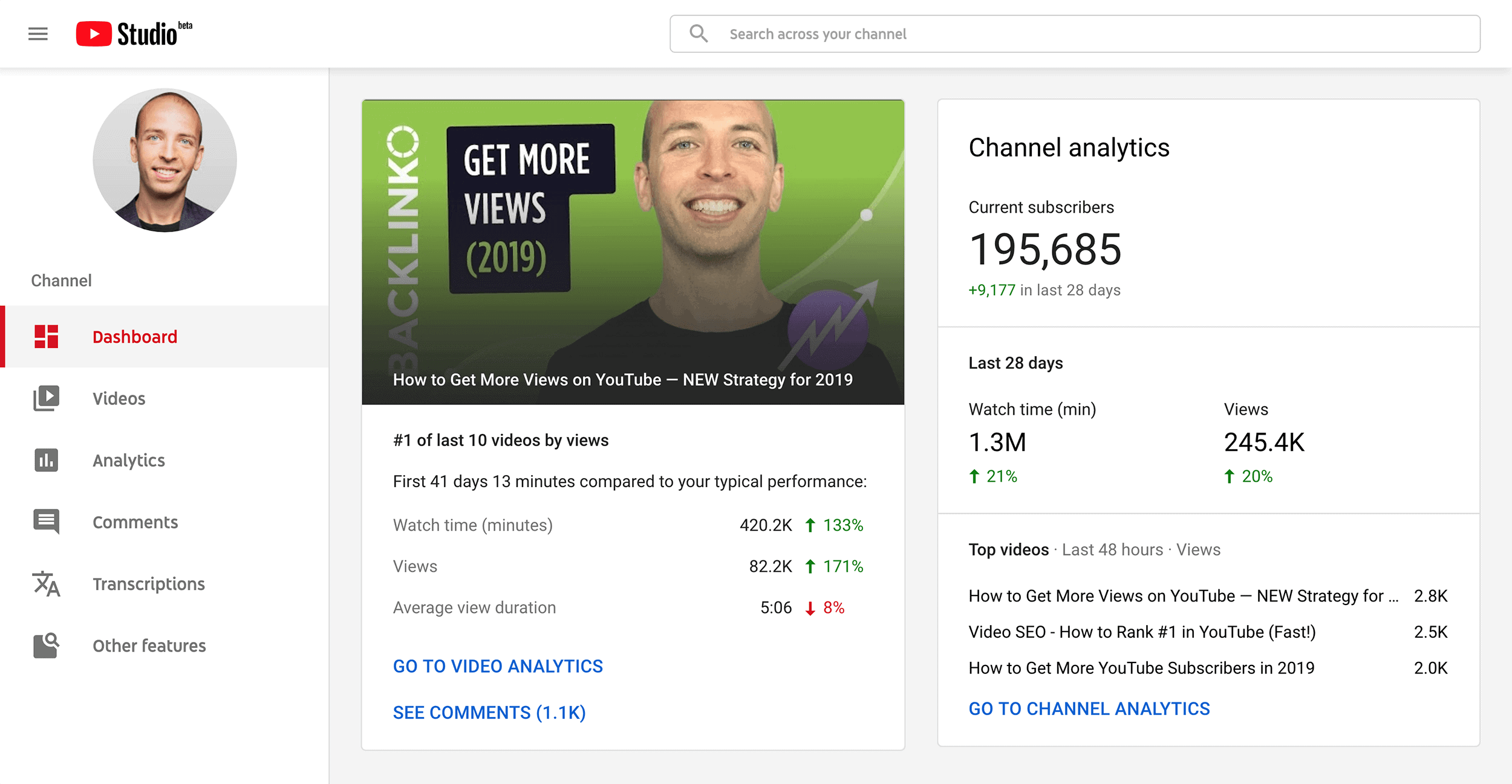
Click “Analytics” and “Reach Viewers”:

Click on “Traffic Source: YouTube Search”.
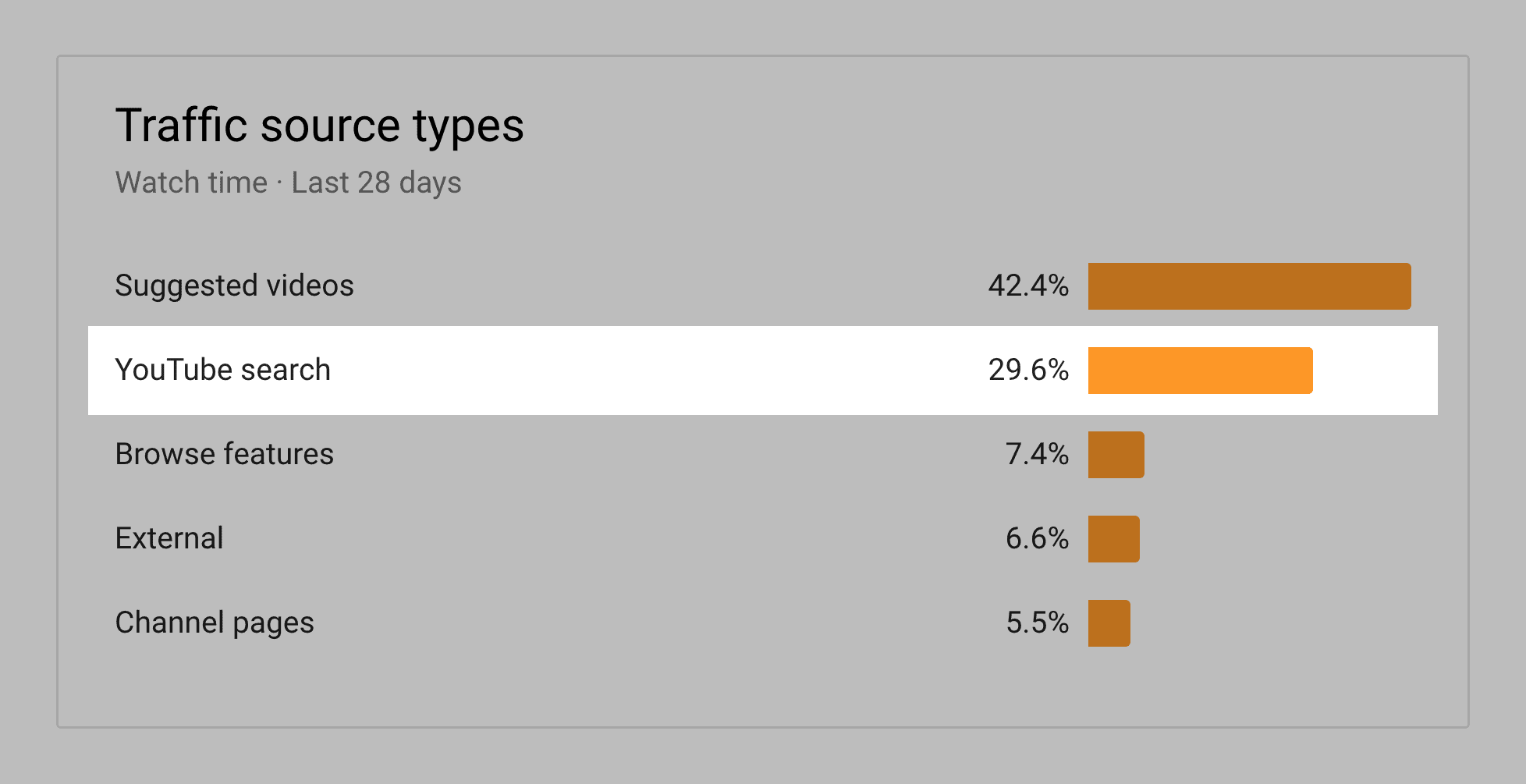
Voila! You can see all of the keywords that you rank for:
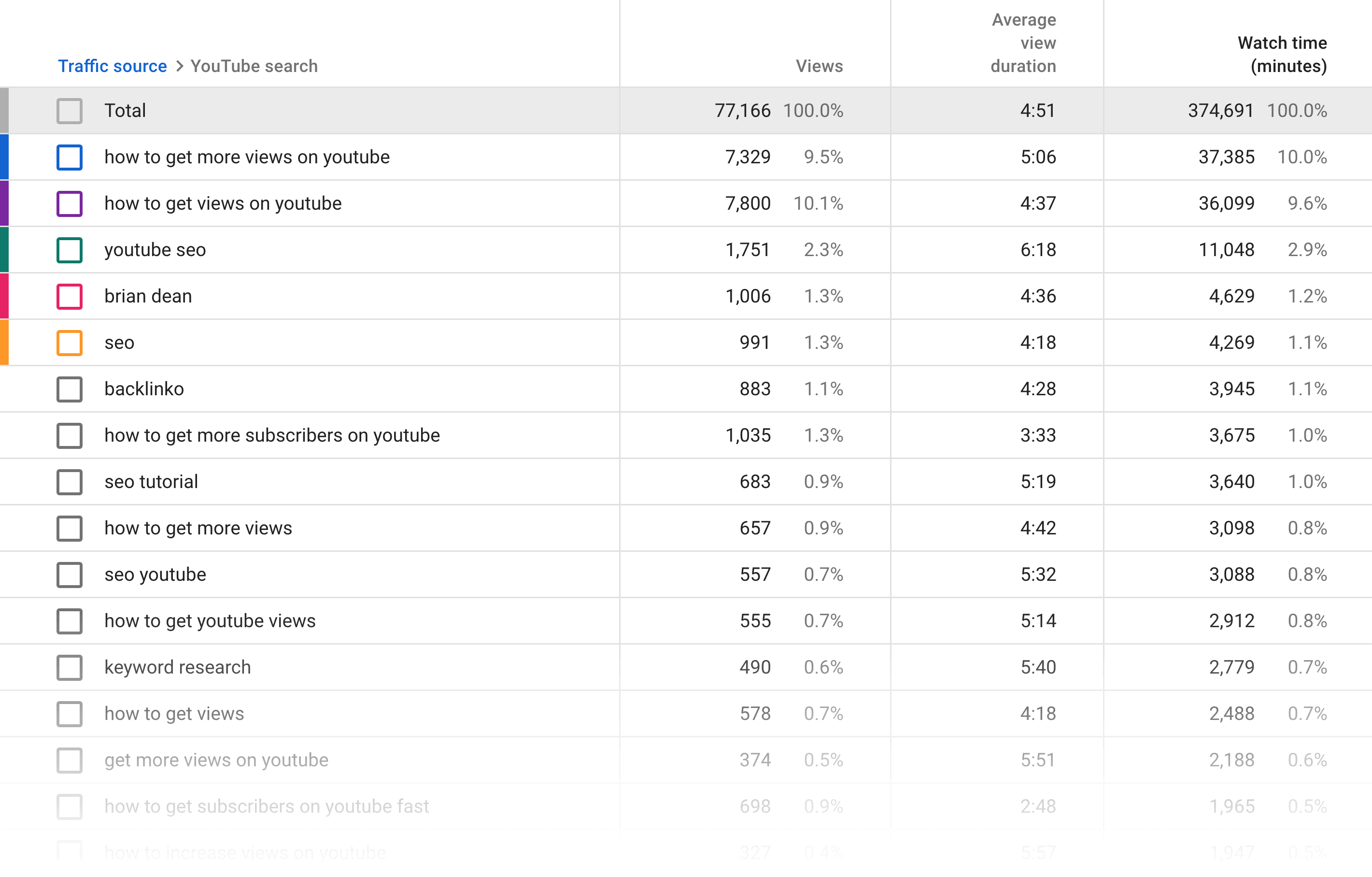
You can do two things with the keywords that you find on this list…
Thing #1: Optimize an Existing Video Around That Keyword
If you have a video that ranks for a keyword — but it’s not well optimized for that specific keyword — optimize your video for that term.
With some video on-page SEO, you can usually blast your way to the top of the search results.
For example, this video of mine ranks #7 for “Google SEO”
But this video isn’t well optimized around that keyword.
So all I’d need to do is add that term as a tag…

…and mention it in my video description.

Simple yet effective.
Thing #2: Create a New Video For That Keyword
This is pretty straightforward:
Instead of optimizing an old video around a keyword, create a whole new video.
This way, your video is laser-targeted for that keyword. Which means it’s likely to rank better than a video that’s only partially optimized around that term
OK, so you have a list of keywords in-hand. Nice work.
What’s next?
It’s time to create an awesome video. And that’s exactly what I’ll show you how to do in Chapter 2.
Chapter 2:Create Awesome Videos

If you want to rank in YouTube, your videos need to be awesome.
The question is:
What does “awesome” actually mean?
A video that’s “awesome” to me might make you want to toss your laptop out the window.
Well in the world of YouTube, “awesome” is measured by a few key metrics, like:
- Session Time
- Watch Time
- Audience Retention
- Engagement
- CTR
And when you create videos with these YouTube ranking factors in mind, you can find yourself sitting pretty at the top of the search results.
With that, it’s time for me to break down each of these ranking signals…
…and show you how to create videos optimized for each one.
Total Watch Time
Total Watch Time is likely YouTube’s #1 ranking factor.
What is Total Watch Time?
Total Watch Time (TWT) is the amount of watch time minutes that your video accrues.
You can see this metric in YouTube Studio:
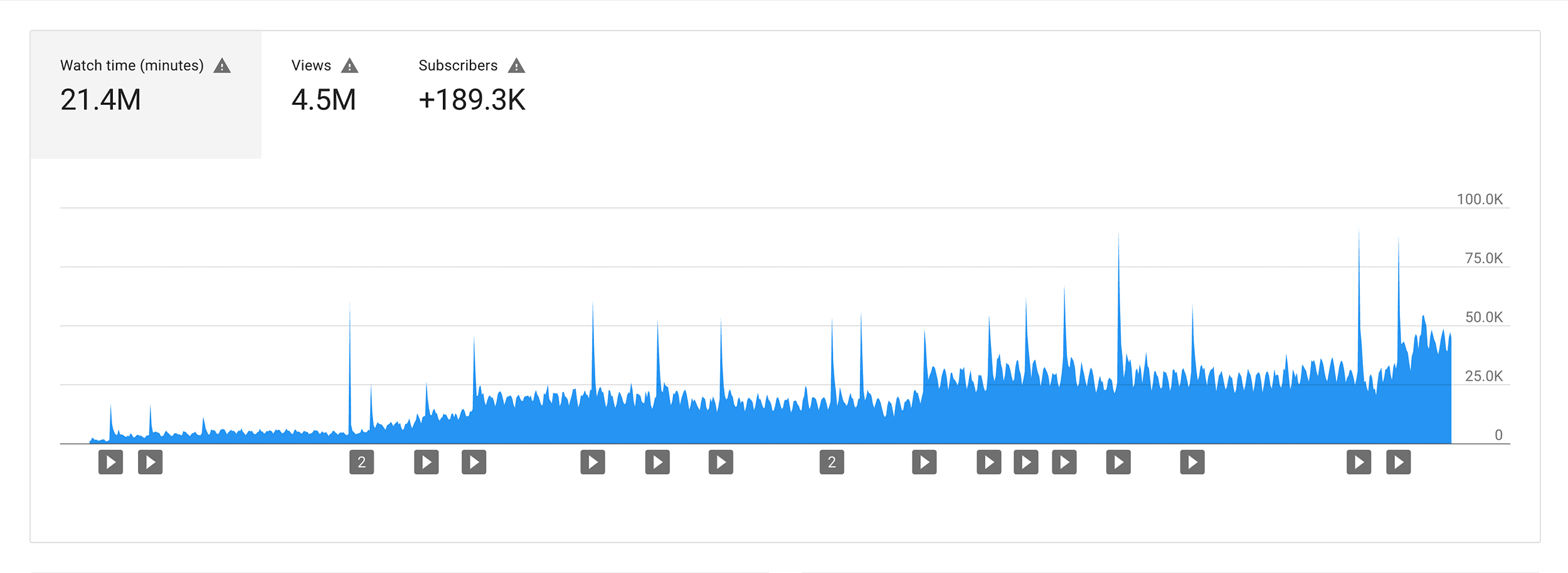
How can you optimize for TWT?
First, create long videos.
Let’s say you publish two videos:
Video A is 12 minutes. Video B is 4 minutes.
And on average, people watch about 40% of each video.
At the end of the day, Video A will have 3x the watch time of video B!
In fact, if you look at the results for competitive keywords, you’ll notice that the top-ranking videos are pretty darn long:
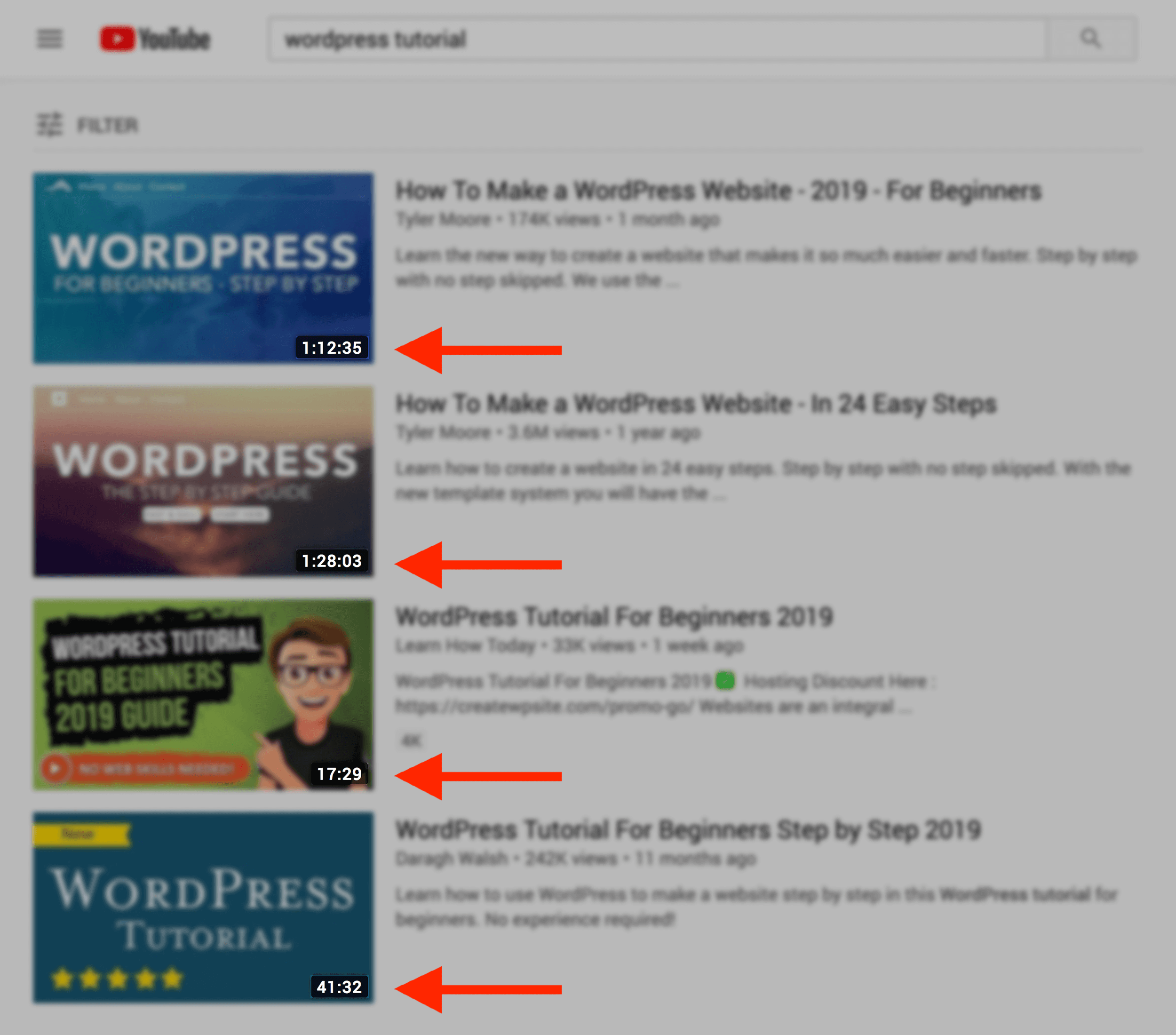
Second, create videos that maximize audience retention.
I’ll show you how to do that right now.
Audience Retention
YouTube’s other big “on video” ranking signal is audience retention.
Audience retention is the amount of your video (as a percentage) that people watch.
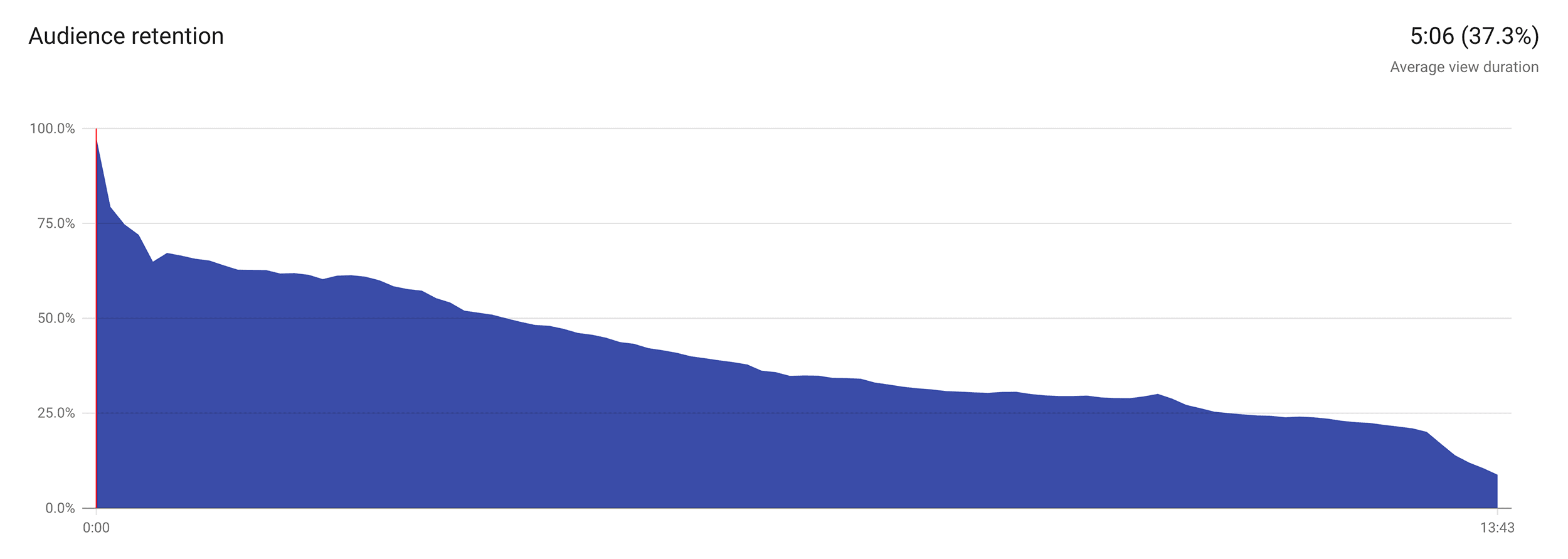
Obviously, the more of your video people watch, the better.
Here’s how to maximize your video’s audience retention:
Focus On The First 15 Seconds
The first 15 seconds of your video is HUGE.
In fact, YouTube recommends focusing on this critical part of your video.
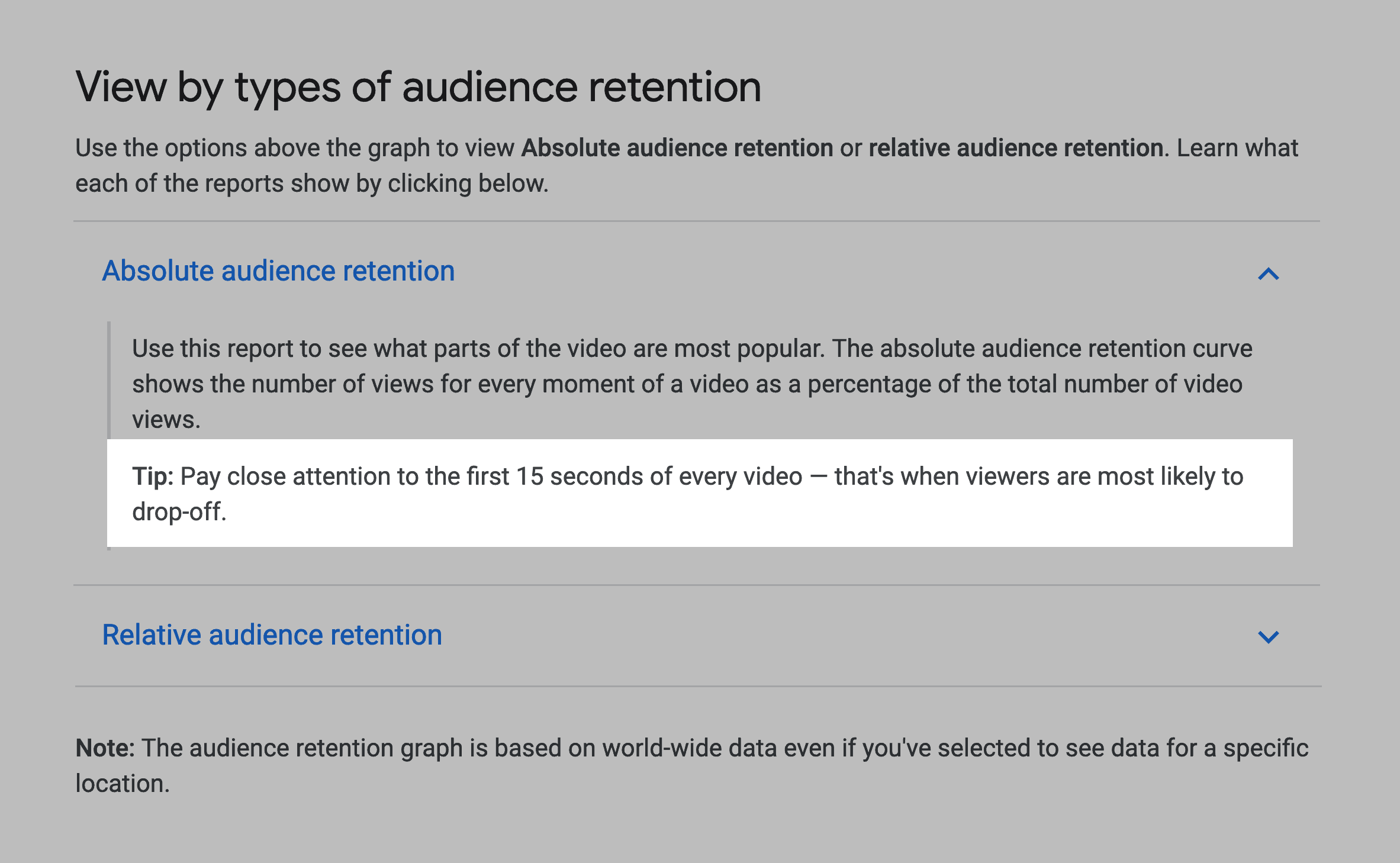
Why?
Because their data has found that if you hook someone in the first 15 seconds, you’ve hooked them for good.
(The opposite is also true. If you lose someone in the first 15 seconds, they’re not going to stick around).
Look For Peaks and Valleys
Spend a few minutes checking out the audience retention reports for your videos.
Specifically, look for spots where audience retention peaks…
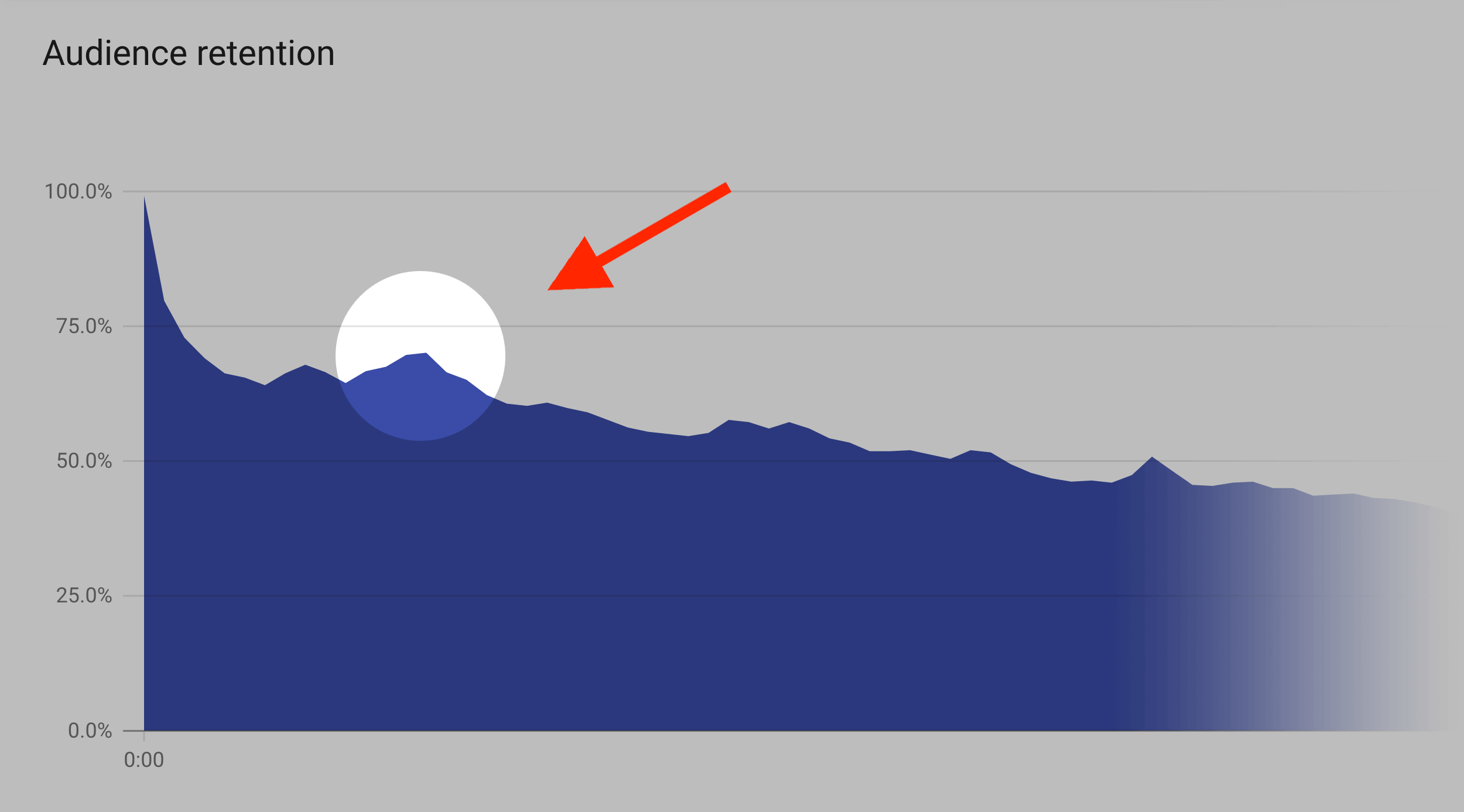
…and drops:

Then, in future videos, double down on what works. And eliminate elements of your video that’s making people click away.
Use “Pattern Interrupts”
Pattern interrupts are moments in your video where you change things up.
And sprinkling in one or two Pattern Interrupts per video can make a BIG difference in your audience retention.
I always add 1-2 pattern interrupts per video (usually me doing something silly):
These brief funny moments reset people’s attention. And instead of clicking away, they keep watching.

Session Watch Time
Session Watch Time is YouTube’s “uber metric”.
It’s basically how long viewers spend on YouTube’s platform after seeing your video.
When YouTube confirmed this ranking factor they stated:
In other words: “We reward videos that keep people on YouTube.”
Unfortunately there’s no way to directly measure Session Watch Time.
(Why? If someone clicks on a video that doesn’t belong to you, you can’t see any analytics for that video. But it WILL add to your video’s Session Watch Time)
If you can’t measure Session Watch Time, how can you optimize for it?
First, create playlists.
That way, your Session Watch Time automatically increases whenever someone watches your playlist.
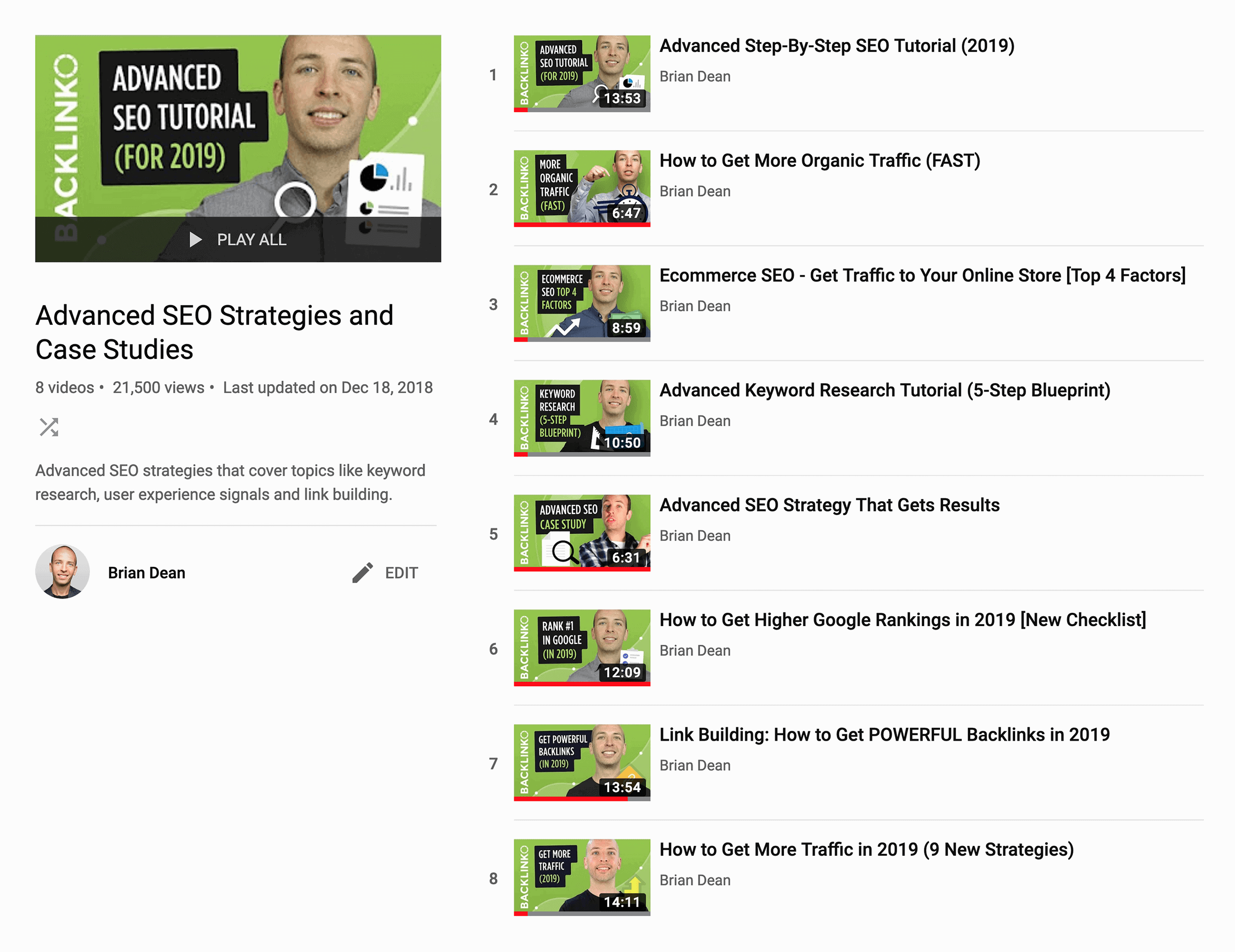
(A win-win)
Next, include links to one of your other videos at the end of each video… and a link to your channel:
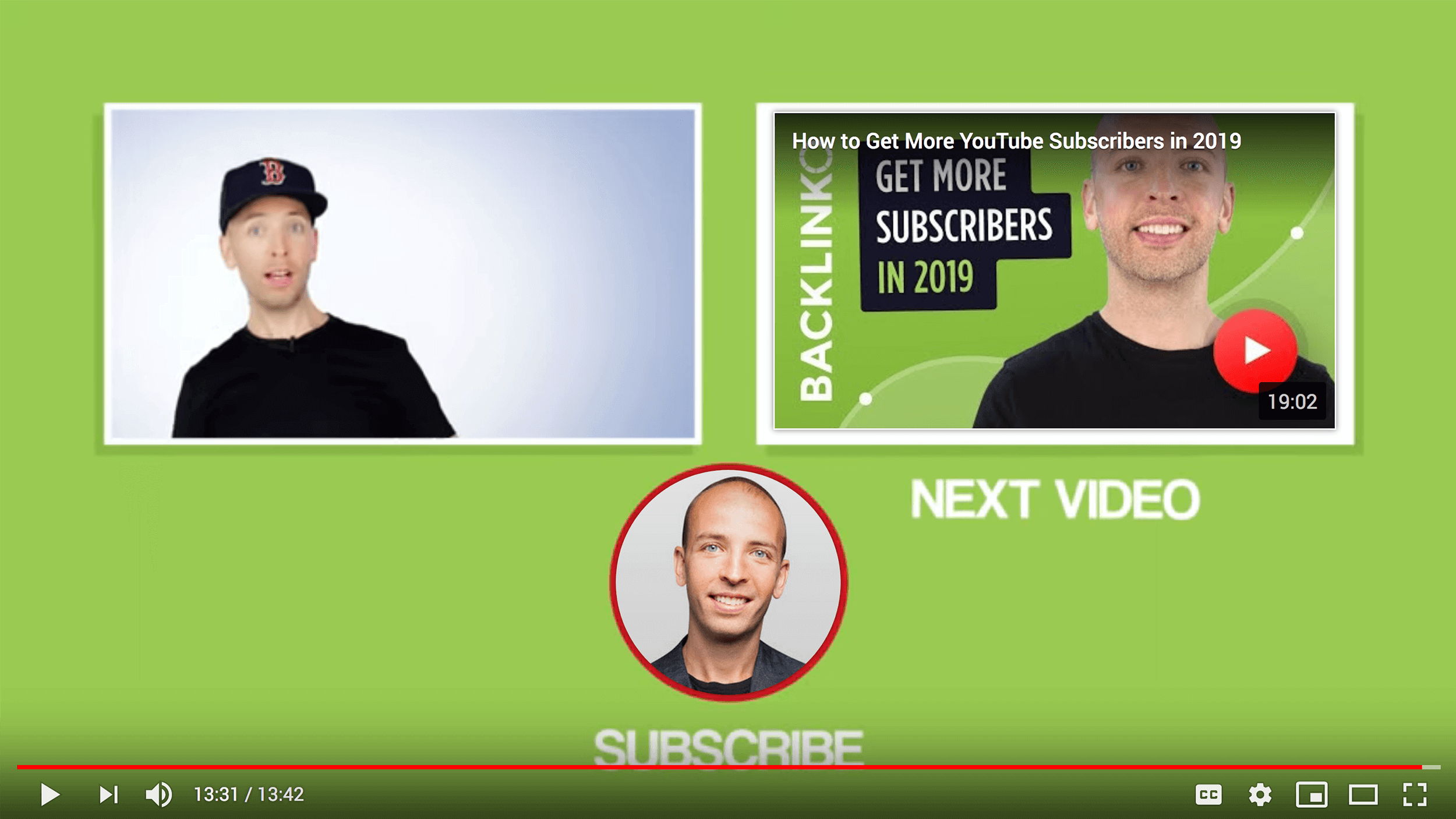
(You’ll need to use YouTube’s End Screen feature to set this up).
Again, this encourages your user to stay on YouTube instead of clicking away.
User Engagement
Now it’s time for another key video ranking signal: User Engagement.
YouTube doesn’t want their users to passively sit back and watch your video.
Instead, they want to see that people actively engage with your video.
Specifically they measure how many people:
- Like
- Comment
- Subscribe
- Share
- Add your video to a playlist
The more of these signals YouTube sees, the more they know that your video is keeping their users engaged on the platform.
Here are 3 tips to maximize user engagement signals:
#1: Ask People to Comment on Your Videos
People LOVE giving their opinions.
But people HATE thinking.
So to increase the odds that people comment on your video, give your viewers something specific to comment on.

#2: Add a Clear “Subscribe” CTA To Your Script
Don’t be afraid to ask people to subscribe to your channel.
In fact, I recommend adding a clear call-to-action at the end of every video, like this:
(Yes, I realize that I look crazy in that shot 🙂 )

#3: Reply to Comments
When you reply to comments, you encourage more people to comment.
More comments=more engagement=higher rankings.
I make sure to reply to 100% of the comments that come in during the first 24 hours that my video goes live:
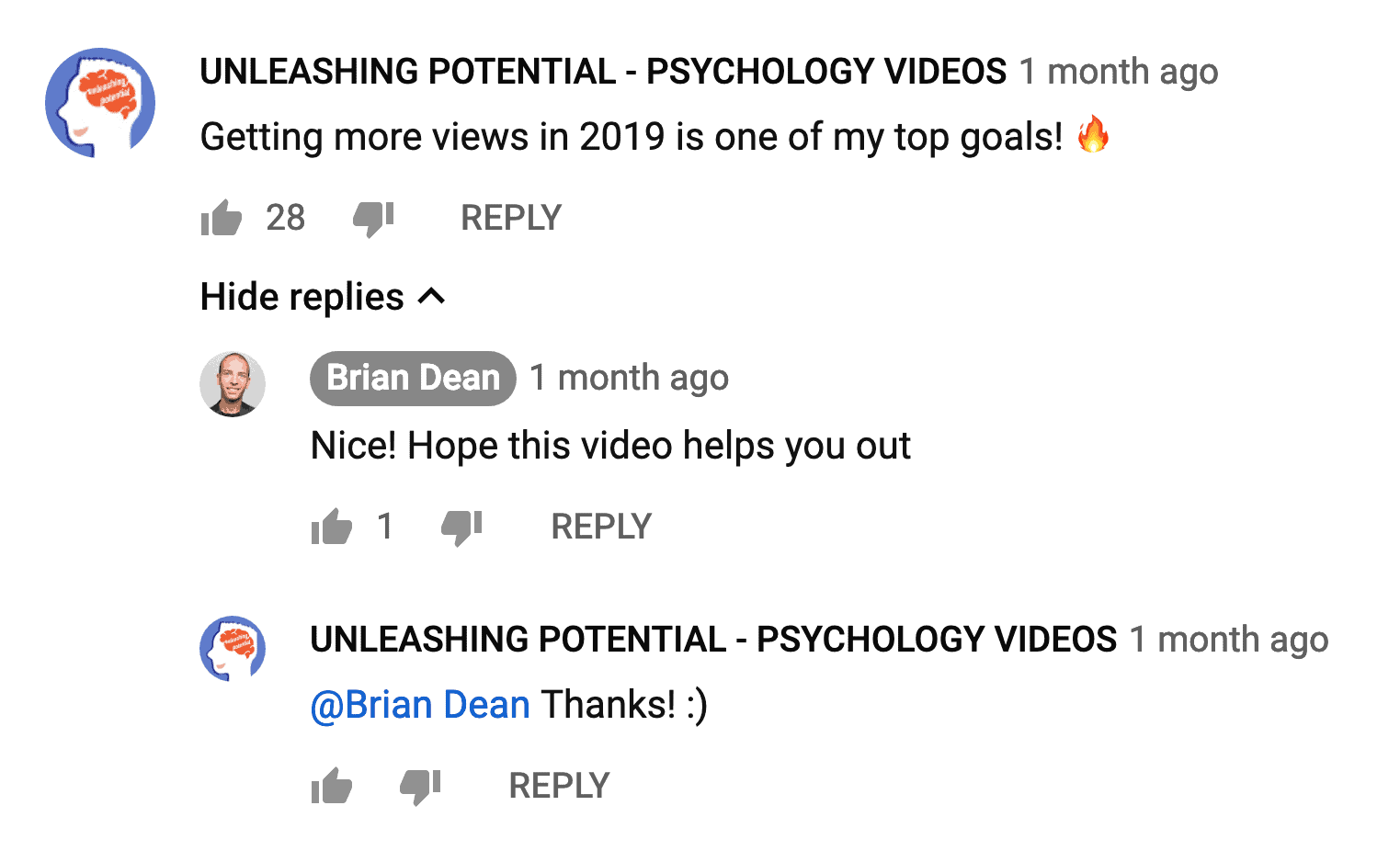
Now that you have an awesome video, it’s time to keyword-optimize it.
That’s what Chapter 3 will show you how to do.
Chapter 3:Video Optimization

Like with a blog post, there’s more to video SEO than publishing an awesome piece of content and hoping for the best.
You also need to optimize your video around keywords that people use on YouTube (and in Google).
Here’s how:
Video Title
You have two goals with your video title:
Goal #1: Include your target keyword.
Goal #2: Maximize click-through-rate (CTR).
I’ll show you everything you need to know about CTR later in this chapter.
But for now, let’s focus on keyword-optimizing your title.
All you need to do here is include your target keyword ONCE in your title.

Video Description
I recommend writing 200+ word descriptions for each video.
Why?
Longer descriptions give YouTube a deeper understanding of your video’s topic.
And this deeper understanding helps your video show up as a suggested video on more videos:

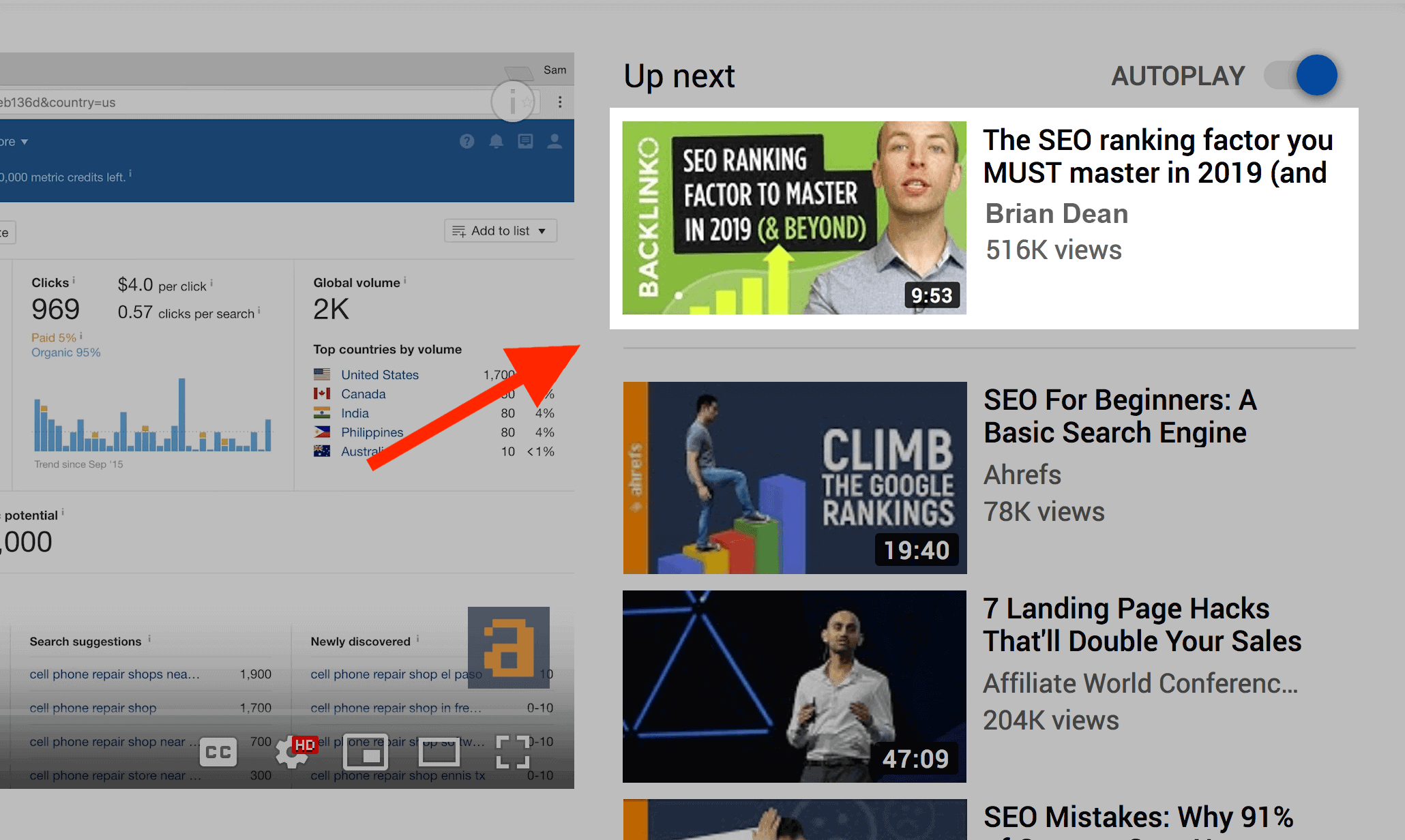
YouTube Video Tags
Tags aren’t nearly as important as they were back in the day.
That said, YouTube still asks for tags. So I recommend using them.
I honestly don’t put a ton of thought into tags.
I simply include 5-ish tags that make sense for my video.

And I make sure that one of the tags is my target keyword.
That’s it.
Say Your Target Keyword in Each Video
Remember that YouTube can understand what you say in your video.
They’re not perfect at it…
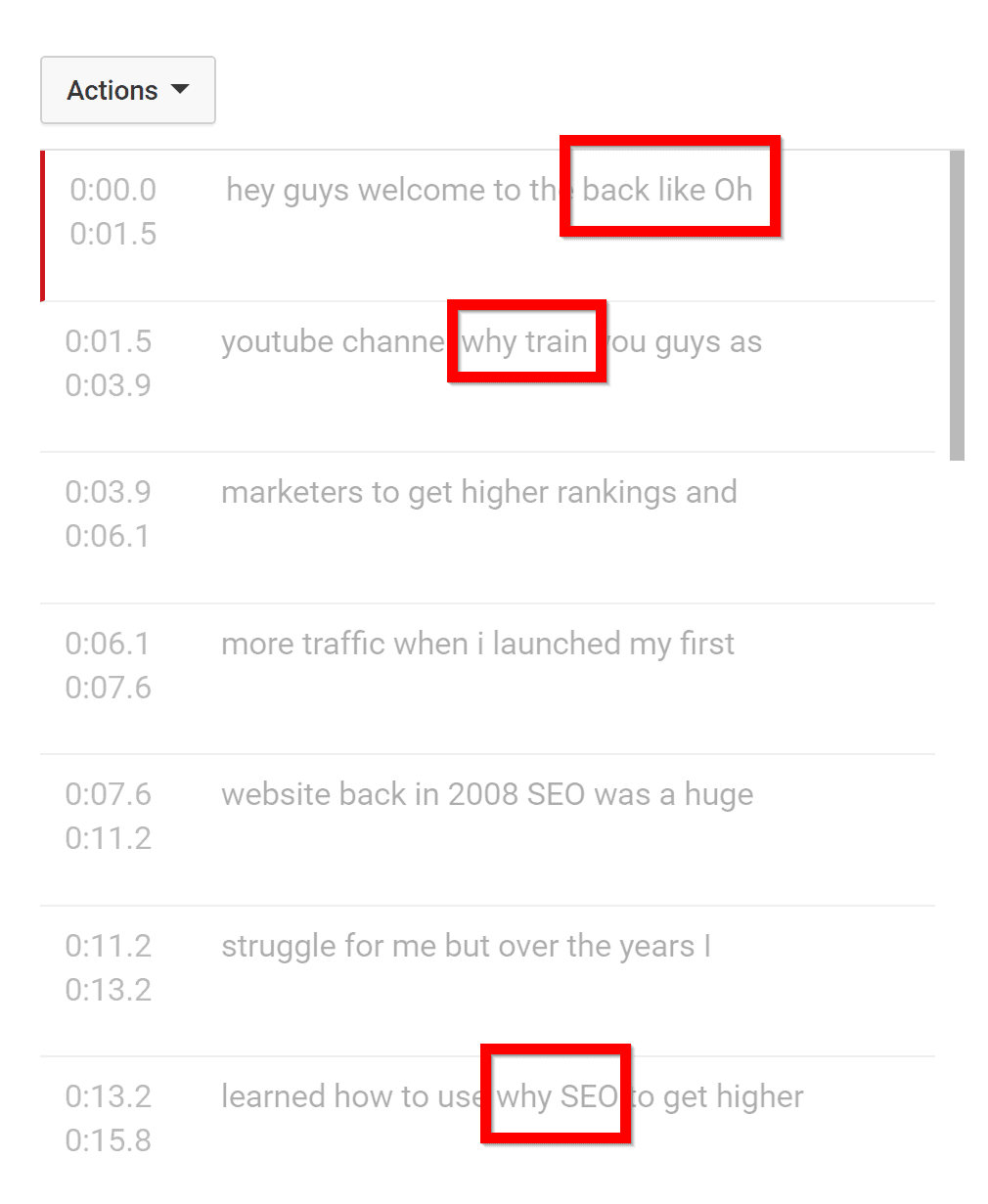
…but in my experience they correctly understand 90% of the words in a given video.
Plus, you can upload a transcript to make sure YouTube gets every word right (more on that next).
And when YouTube hears you say your target keyword in your video, it helps them understand that your video is about that keyword.
That’s why I make sure to say my keyword once or twice per video:
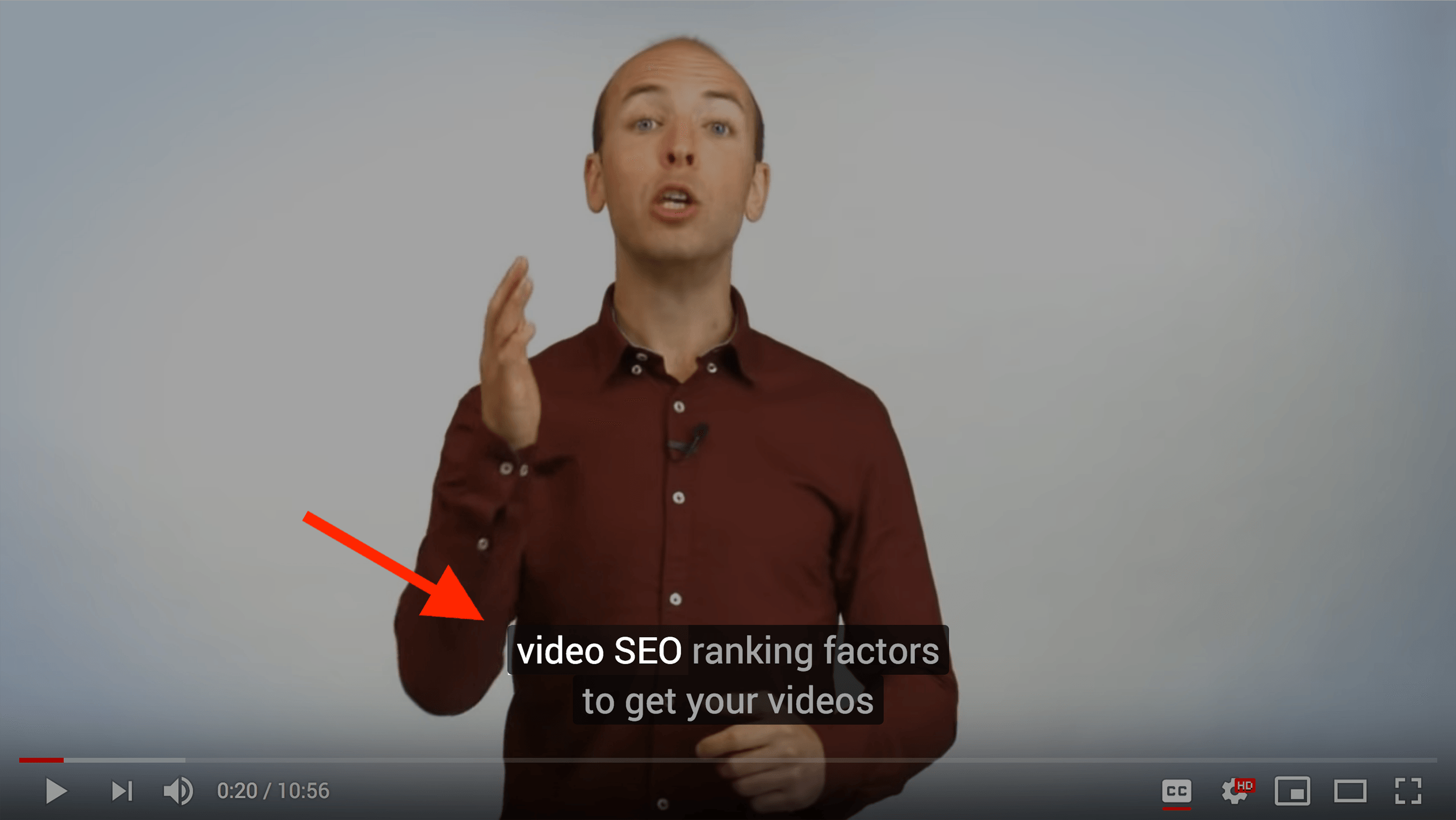
Upload a Transcript
A transcript helps YouTube fully understand your video’s topic.
In my experience, this helps your video show up in more suggested videos.
Optimize Your Video for CTR
My experiments have revealed that YouTube uses CTR as a BIG ranking signal.
If lots of people search for a keyword in YouTube — and click on your result — you’ll likely get a rankings boost.
The question is:
How can you optimize your video for CTR?
CTR Booster #1: Compelling Title.
Yes, you want to include your target keyword in your video title. But the rest of your title should be dedicated to attracting more clicks.

Pro Tip: Don’t use clickbait titles. Yes, you’ll get more clicks in the short-term. But your audience retention numbers will make YouTube bury your video.
CTR Booster #2: Eye-Catching Thumbnails.
Pro YouTubers know that your thumbnail can make or break your video’s success.
So make sure to create a custom thumbnail that stands out.

CTR Booster #3: Attention-Grabbing Description.
YouTube displays the first 125 characters of your description in the search results.

Your first 125 characters should compel someone to click on your result.
OK so you have a kick-butt video that’s optimized for your target keyword.
Now it’s time to dive into one of the most underrated video SEO ranking signals: channel authority.
Your Channel’s Branding and Messaging
Here’s where you answer the question:
“How is your channel different than all the others on YouTube?”
If your channel doesn’t answer this question, new visitors have to wonder why you exist. And you’ll miss out on potential subscribers.
But when you broadcast a consistent message, your target peeps will slam the “subscribe” button.
In my case, I knew that my target audience wanted to get “higher rankings and more traffic”.
So I made my channel’s slogan: “higher rankings and more traffic”.
Simple, yet effective.
And in the rest of this chapter I’ll show you actionable tips you can use to boost your channel’s branding and authority.
Your Channel Header
Make sure to include your channel’s slogan here.
Here’s an example from my channel:

Animated Logo
Your animated logo is HUGE for your channel’s brand.
In the early days of my channel, I’d simply include my company logo:
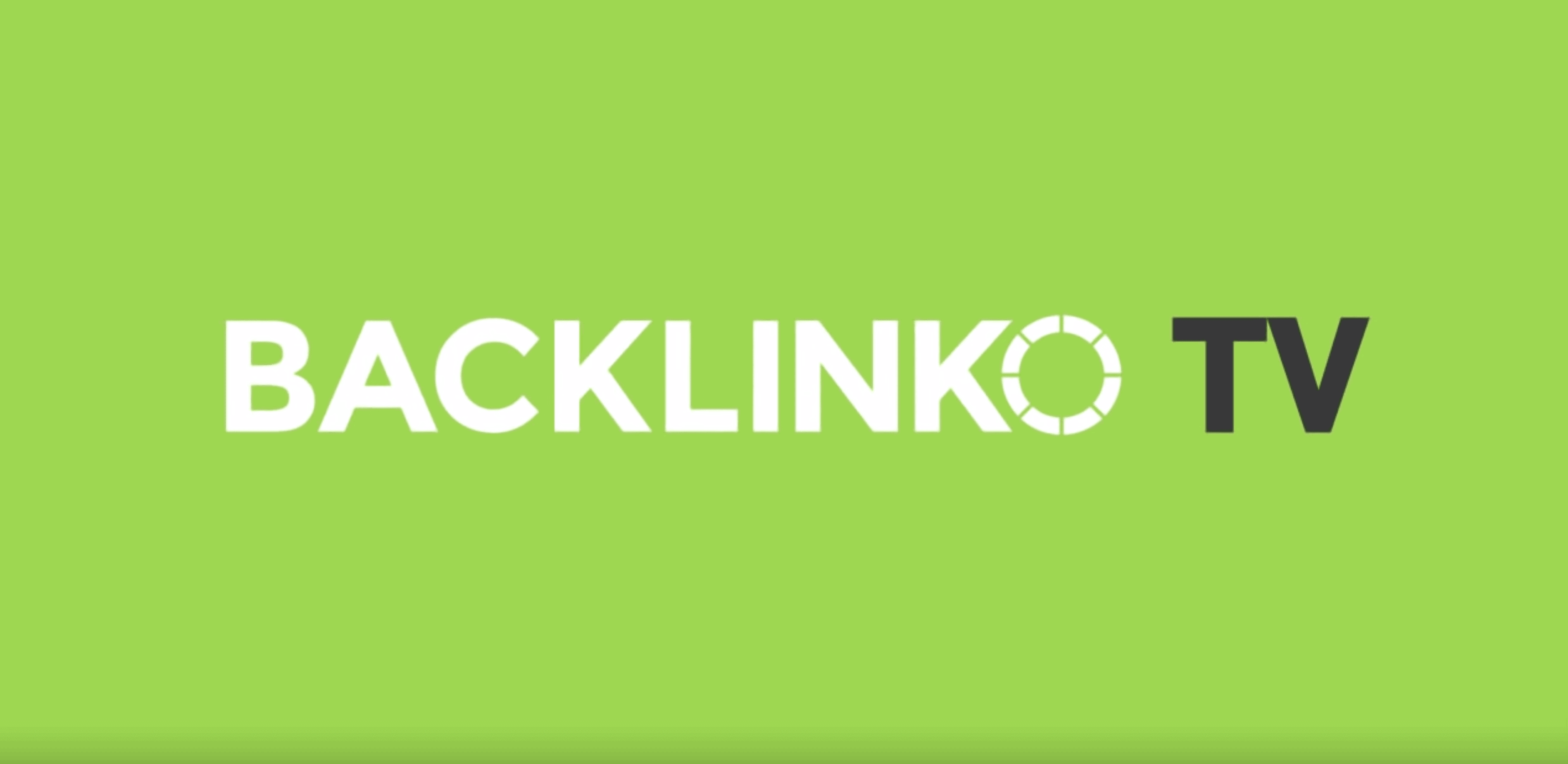
Today, I also include my channel slogan:
That way my brand message is reinforced with every video view.

About Page Description
Don’t forget to include your slogan early in your channel’s about page:
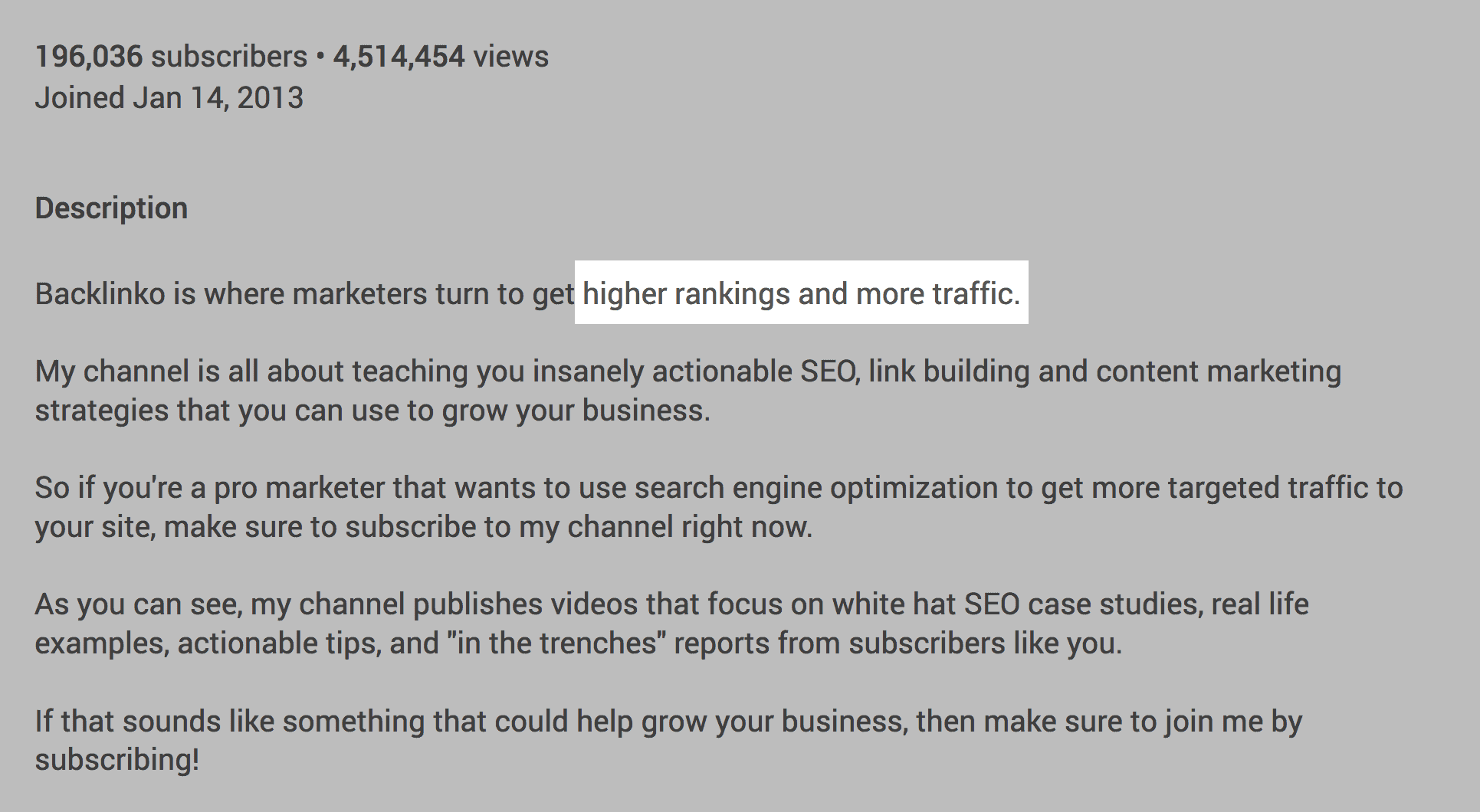
Pro Tip: Also include a few keywords in your channel description. This can help your channel show up in the search results. Here’s an example:

Playlists
Your playlists should represent what your channel is all about.
For example, my channel has a playlist called “Advanced SEO Strategies and Case Studies”:

Because my channel targets pro marketers (not newbies), this playlist appeals to that group.
Pro Tip: Keyword-optimize your playlists for long tail keywords. That way your playlists can rank for that term:
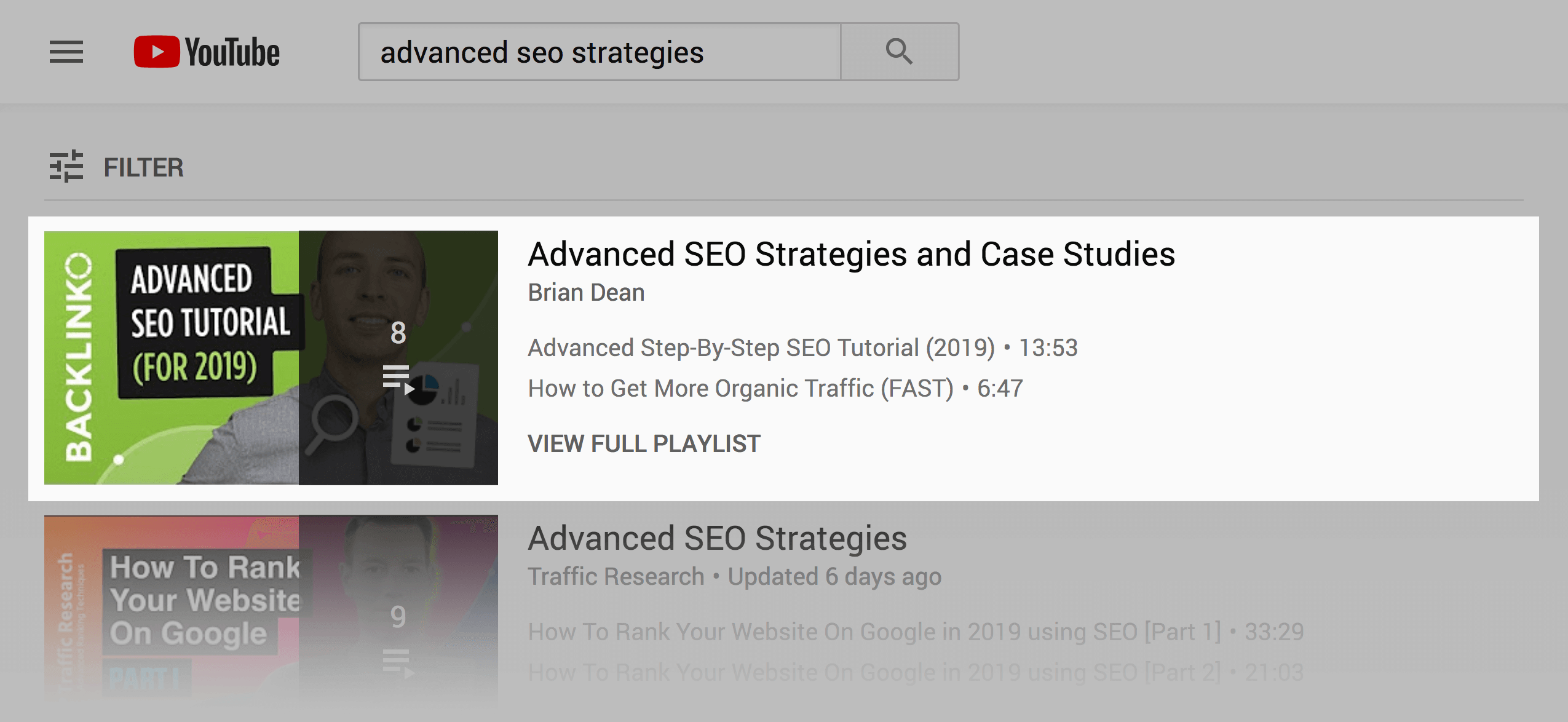
Number of Subscribers
Do channels with more subscribers get a built-in rankings boost?
It’s hard to say.
After all, popular channels get more views every time they publish a new video.
So it’s impossible to know whether your subscriber count is a direct — or indirect — ranking factor.
Either way, the more subscribers you have, the better your videos will perform in YouTube.
Here’s how to get more subscribers:
#1: Channel Trailer
Your trailer is your channel’s pitch.
Besides your header, it’s the first thing someone sees when they visit your channel:
You have about a minute to answer these questions from potential subscribers:
- Who are you?
- Why should I care?
- What makes your channel unique?
- Why should I subscribe?
But if you can answer these questions, you can turn your viewers into loyal subs.

Here’s an example of an excellent trailer:
What makes this trailer awesome?
- It’s short (a shade over a minute)
- It’s funny
- It leaves ZERO doubt about what the channel is about
#2: Ask People To Subscribe At The End of Every Video
I mentioned this in chapter 2, but it bears repeating here.
Ask viewers to subscribe to your channel…at the end of every video.
If someone made it all the way to the end of your video, they’re primed to subscribe. And sometimes all they need is a little nudge.
Your “subscribe to my channel” CTA is that nudge.
I mean, even the Star Wars YouTube channel does it.

(Consider your subscription CTA a Jedi Mind Trick. At least that’s what I do ;-D )
#3: Link to Your Channel From Your Site
Make sure to add a YouTube link to your list of social media profiles.

Chapter 5:Ranking Videos In Google

In this chapter you’ll learn how to rank videos in Google.
The Secret to Getting Your Videos Ranked in Google
Here’s the deal:
Google earmarks certain keywords for video results.
I call these “Video Keywords”.
And the secret to ranking your videos in Google is to target Video Keywords.
In my experience, if you optimize your video around a keyword that doesn’t already have a video in Google, it’s going to be VERY hard for it to rank.
For example, “how to clean an iphone” is a video keyword:

How to Find Video Keywords
The simplest way to find Video Keywords is to search for your potential keyword in Google.
If you see at least one video result in the top 10, great.
If not, you may want to consider a different keyword.
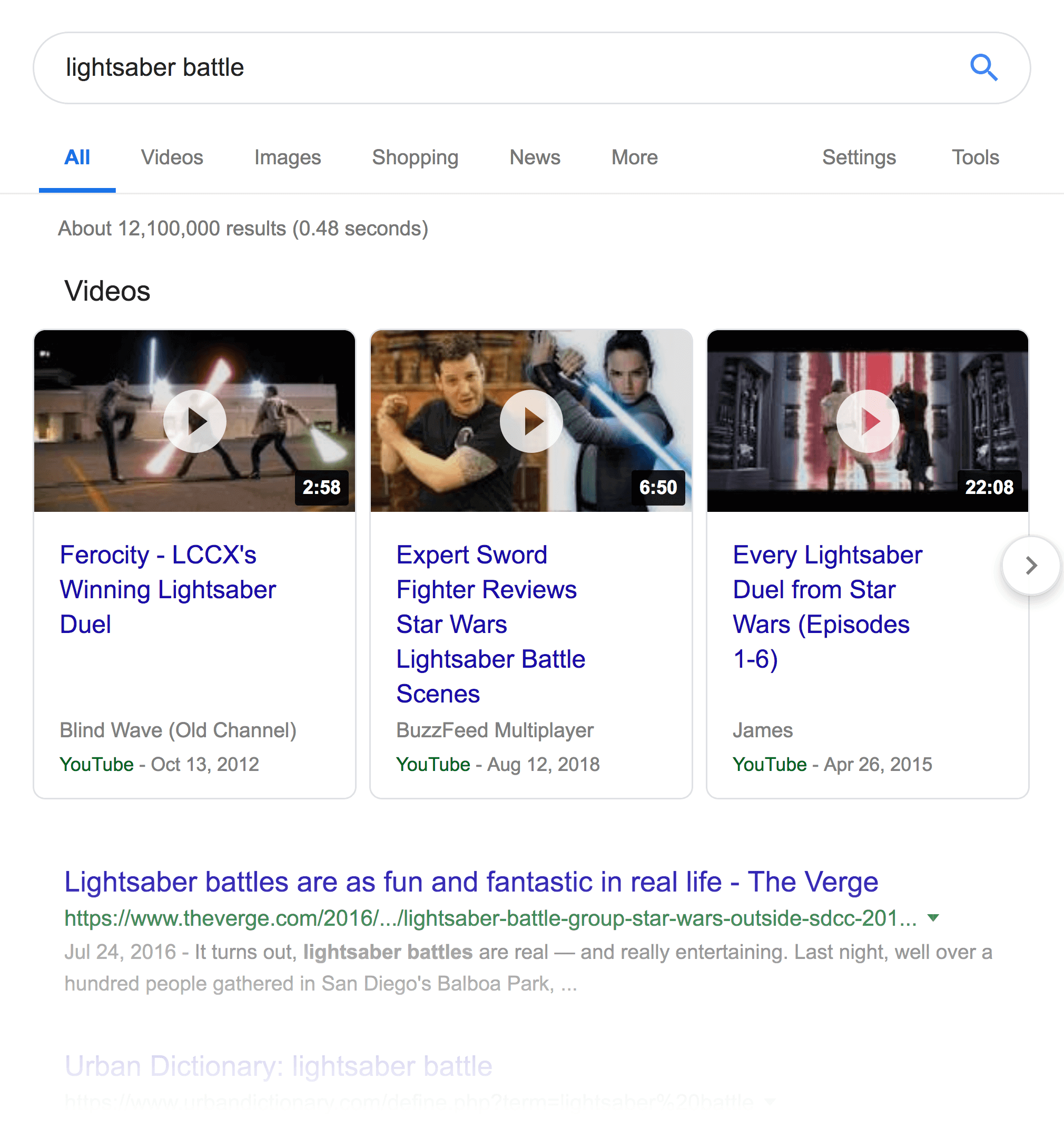
Pro Tip: The top 3 spots in Google get 55% of all clicks. So keep an eye out for keywords that have a video result in the top 3. Your video won’t get nearly as much traffic if it ranks in positions 4-10.
How to Rank YouTube Videos in Google
Now that you’ve created a YouTube video around a Video Keyword, how do you get it to show up in Google?
The “secret” is to create an awesome video (which covered Chapter 2) and then optimize that video (which is what Chapter 3 is all about).
Other than that, it’s all about getting backlinks to your video. Like any page on the internet, the more high-quality backlinks you build, the higher you’ll rank.
I show you how to promote your videos in the next chapter.
Ranking Self-Hosted Videos in Google
What if you self-host your videos on your site?
For example, let’s say that you post your videos to your blog with a service like Wistia.
Can you get those videos to rank?
Technically…yes. But it’s A LOT harder to rank a self-hosted video than a YouTube video.
In fact, 82% of all video results in Google are from YouTube.
(Considering that Google owns YouTube, this shouldn’t come as a surprise).
That said, it is possible to rank self-hosted videos.
Here’s how:
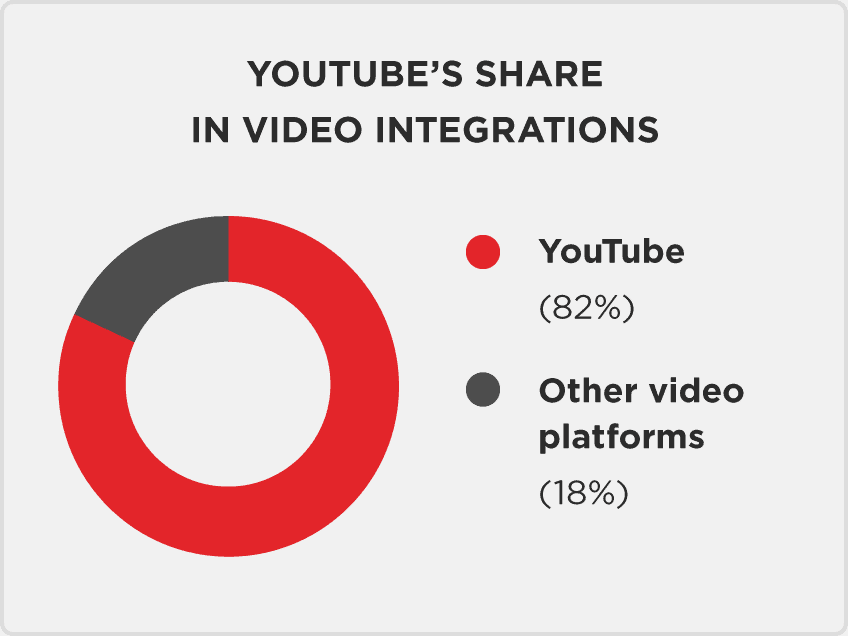
#1: Put The Video at The Top Of Your Page
This shows Google that your video is the main piece of content of that page.
So make sure your video is at the very top of the page…or right after a brief text-based intro:
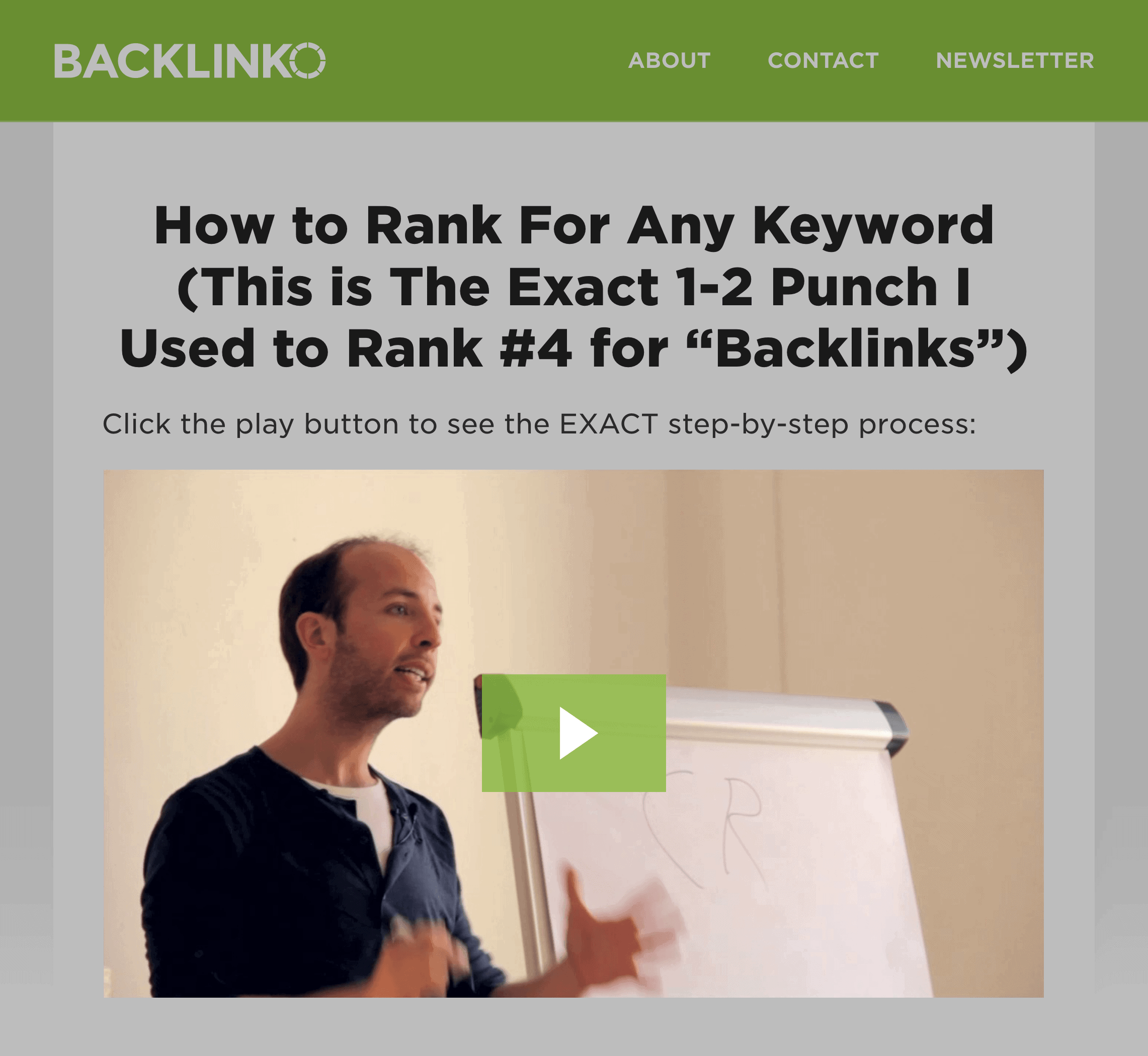
#2: Publish a Transcript Below Your Video
A full transcript below your video helps search engines understand what your video is all about.
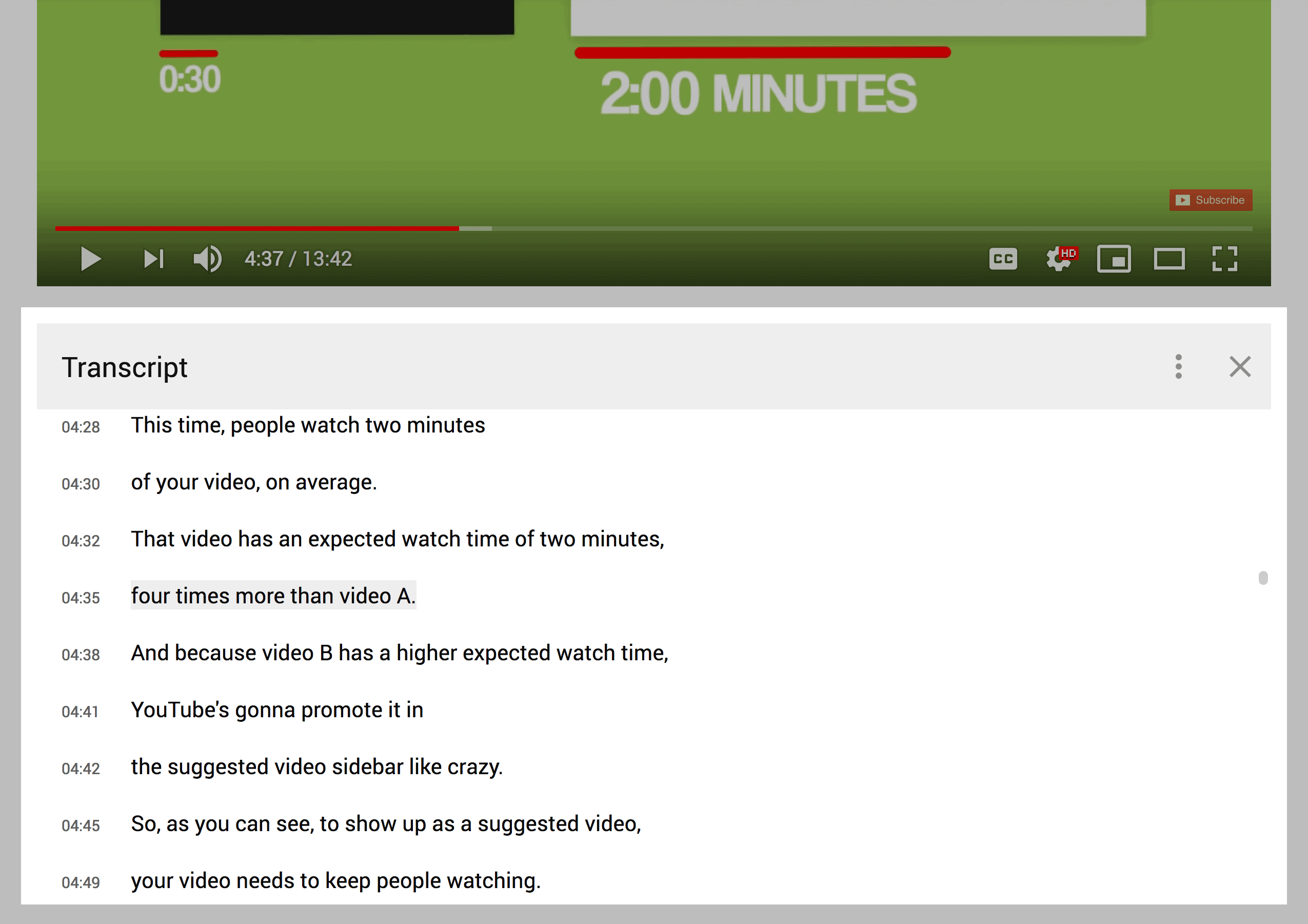
Pro Tip: Optimize your transcript for readability. Most people just copy and paste a big ol’ transcript. Instead, make your transcript easy for people to read and skim. This will improve your dwell time and reduce bounce rate –two key Google ranking factors.
#3: Use Video Schema
Google and Bing both support Video Schema markup.
This guide from Google will give you the full run-down.
But in general, here’s what you need to have in place:
- Keyword-Rich Video Title: Don’t use a generic title like “video 5_version 3.4”. Instead, write a title like: “5 Ways to Rank Videos in Google”.
- Video Description: This is a brief description of what your video is all about. Make sure to use your target keyword once here.
- Video Duration and Upload Date: No description needed (I hope 🙂 )
- Eye-Catching Thumbnail: This is what will appear in Google’s search results, so make it good.
You can set up this schema code manually. But it’s kind of a pain. Instead, I recommend hosting your videos with Wistia or using the the Yoast WordPress plugin for videos.
Now that your video is live, it’s time to get the word out.
Chapter 6:Video Promotion Strategies

400 hours of video are uploaded to YouTube…every minute.
(Seriously, take a second to think about how crazy that is).
With so much video flying around the platform, even your best videos need serious promo.
And in this chapter I’ll show you how to promote your videos.
Announce New Videos to Your Email List
This is simple…but darn effective.
Whenever you publish a new video, let your email subscribers know about it:

This is a win-win.
Your subscribers get access to premium video content. And your video generates lots of high-quality views.
This view spike can push your video to people’s YouTube homepages…
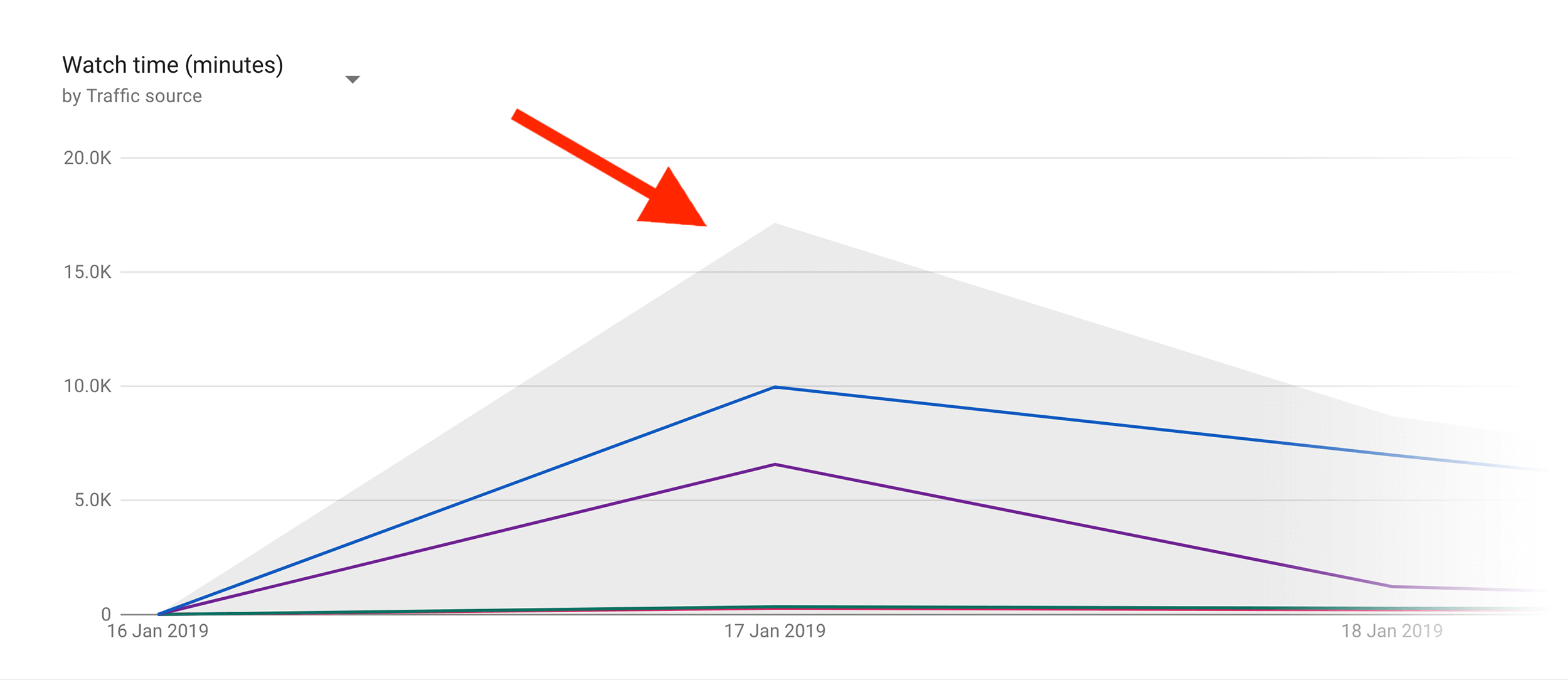
…which leads to more views.
Pro Tip: YouTube suggests videos on your homepage that are similar to videos you recently watched. And this is now bigger than YouTube search and “Suggested Videos” combined. So you 1000% need to optimize videos so they appear on the homepage.
You can easily see if your video shows up on people’s homepages. Go to your YouTube Studio Analytics. Click on “Reach Viewers”—>”Traffic Source Types”—>“Browse Features”:

If your video is high-quality and well optimized, it should pop up in the homepage after a few days of promo.
And if your video is up to snuff, it’ll rank in YouTube’s search results in no time.
Share Your Videos On Social Media
I know what you’re thinking: “Thanks Captain Obvious!”
It’s not as effective as promoting videos to your email list. But you can get some buzz on your new video by sharing it on Twitter, Facebook and Pinterest:

Pro Tip: Ask your social media followers to subscribe to your YouTube channel.

If they follow you on social they’re VERY likely to hit your channel’s subscribe button without thinking twice.
Embed Videos In Your Blog Posts
Embeds help your videos rank for two reasons:
- Embeds are a YouTube ranking signal
- Embeds create a backlink to your video
So don’t be afraid to embed your best videos in your blog content.
These embeds can make a HUGE dent in your video views (especially if you don’t have a lot of subscribers yet).
And it’s a subtle way of letting your readers know that you have an awesome YouTube channel.

Promote Other Videos In Your End Screen
I always put a “Next Video” on my end screen.
This little trick promotes videos that need some TLC. And it boosts your Session Watch Time.
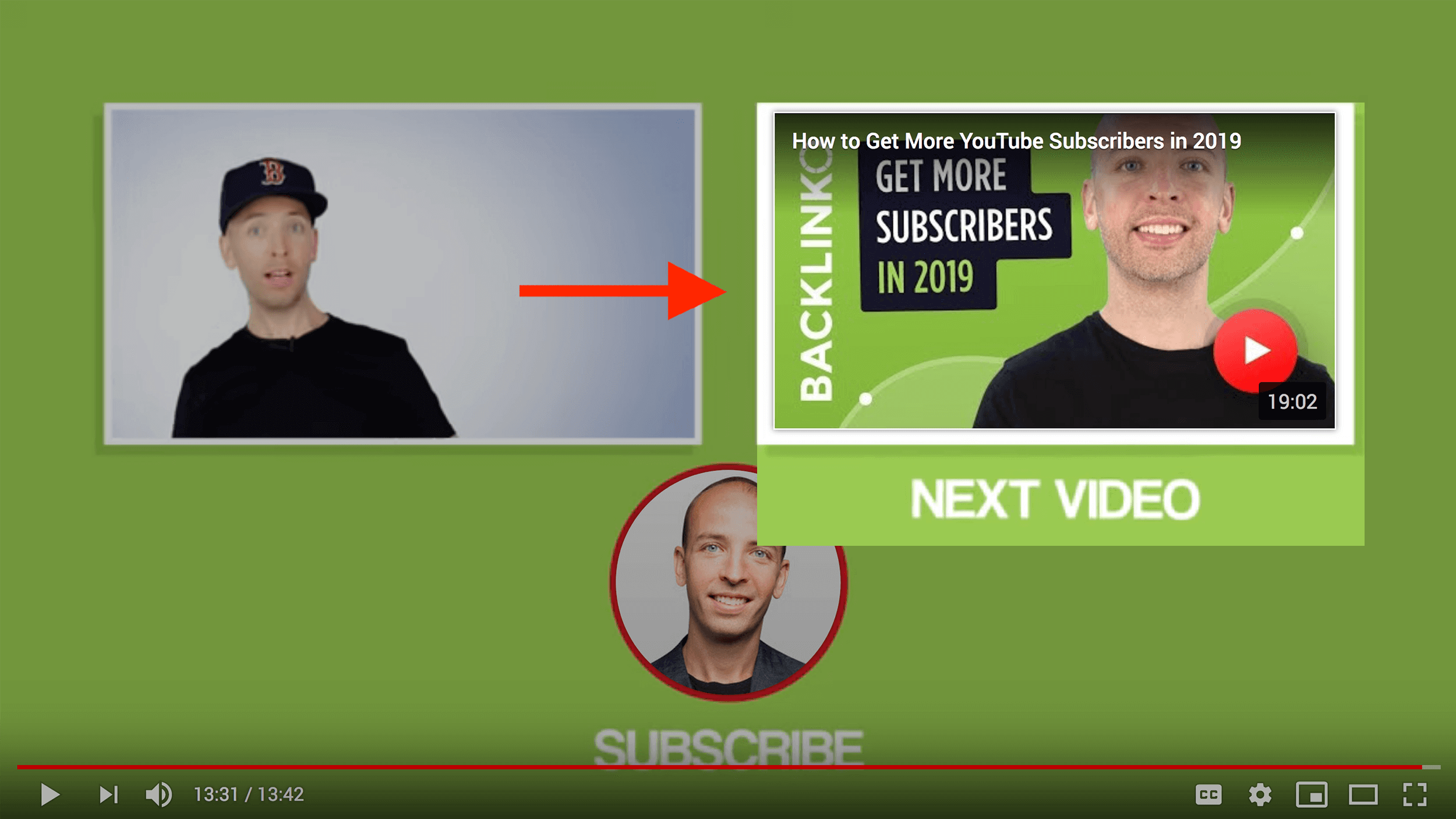
Share Videos on Forums and Quora
First, keep an eye out for a question that your video could help answer.
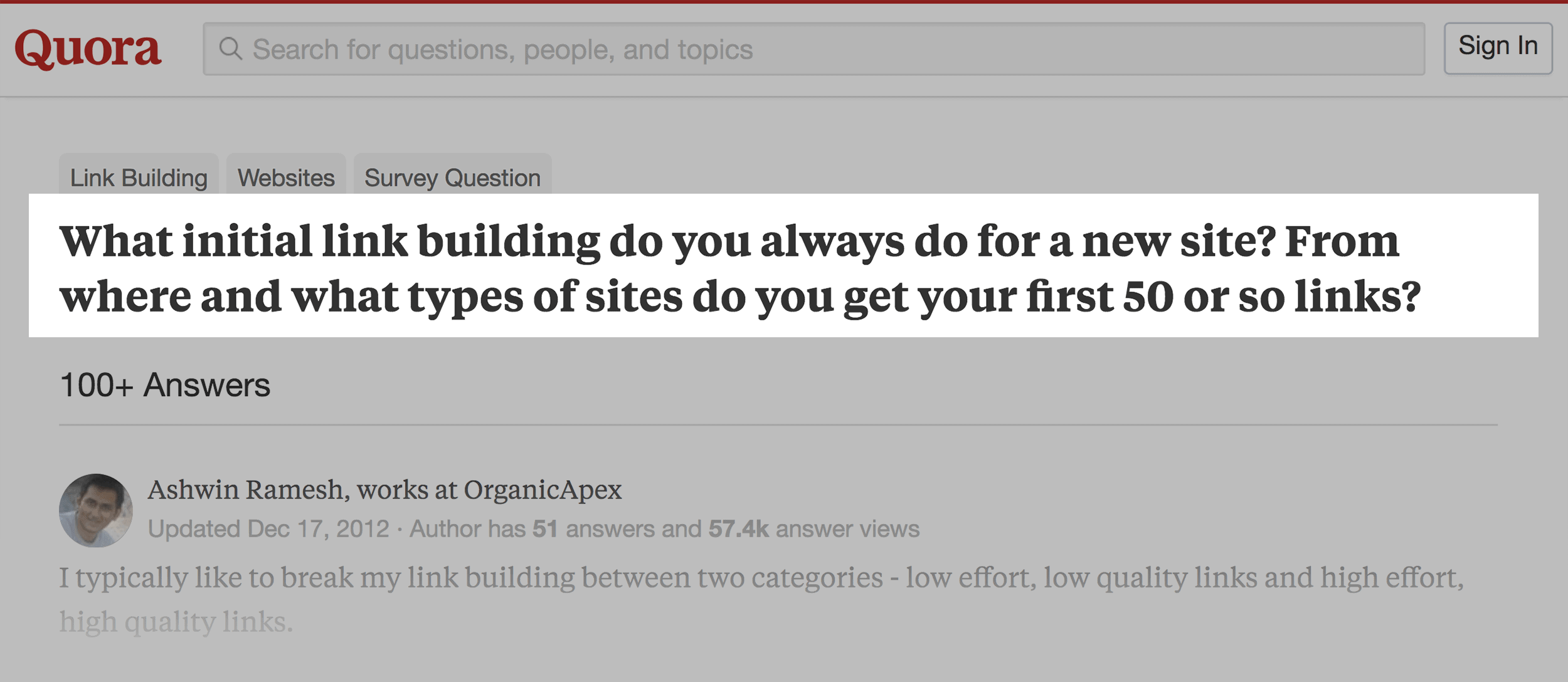
Then, provide a full answer in text form.

Finally, link to your video as a way for people to find more info on that topic.
